[Please Note: As of June 18th, 2013 I have published an in-depth update for the Stages Power, based on new firmware. Please see that update post here. While vast chunks of this review around background/unboxing/etc remain unchanged, I will note in sections that may be affected. Finally, in an effort to consolidate questions/feedback, I’ll be closing this review to new comments – but any new comments may be left on the updated review. Thanks!]
Since its announcement at Interbike this past year, no power meter has caused as much Internet discussion and debate than the Stages power meter. It was previously named “StageOne”, but has since simply been renamed to Stages Power. The unit attracted attention for two reasons, first was the low $699 price point – and second, was the fact that it only measured on the left leg.
Stages Cyclinghas provided me a trial unit test out. Since installing it on my bike I’ve been using it near-daily, mostly with various beta firmware drops, but more recently in pretty-close-to-final (if not final) firmware versions. In doing so, I’ve got a pretty good grasp on how the unit works, as well as all the inside and out details. Because I want to be transparent about my reviews, once my evaluation period with the Stages PM has elapsed, I will send the crank-arm back to them in Boulder, Colorado. Simple as that. Sorta like hiking in wilderness trails – leave only footprints.
Lastly, at the end of the day keep in mind I’m just like any other regular triathlete out there. I write these reviews because I’m inherently a curious person with a technology background (my day job), and thus I try and be as complete as I can. But, if I’ve missed something or if you spot something that doesn’t quite jive – just let me know and I’ll be happy to get it all sorted out. Also, because the technology world constantly changes, I try and go back and update these reviews as new features and functionality are added – or if bugs are fixed.
Cut To The Chase Summary:
(As part of the survey last week, some of you expressed an interest in a cliff notes version of the review at the beginning of the review in addition to full review. We’ll see what you think.)
This is the executive summary version of the review. It doesn’t cover all the detail that the few thousand other words and hundred plus photos do, but it gives you the quick version. As always, there’s substantial detail (especially around pros and cons) in the full review, and as is usually the case in all products – the devil is in the details (both good and bad).
Overview: The Stages Power Meter (no longer called StageOne) is a left-crank arm based power meter that measures your left leg power and doubles it to determine total power. It does this by attaching a pod to the crank arm of an approved crank. These approved cranks must be purchased from Stages, due to the attachment/baking/curing process of adding the pod to the crank arm. The pod adds 20g of weight – which is the same weight as a Kraft American Cheese Singles slice. The crank prices start at $699, which is a bit below other hub-based systems out on the market today. They have a slew of crank arms on the market today, though are missing notables like ROTOR cranks. In general, they’d prefer to partner with everyone and their cousins, but it’s up to the crank arm company to ‘approve’ of the solution. Stages won’t offer a pod for a crank unless the crank-arm company is willing to still ensure the system is certified and supported. While some would prefer Stages simply add pods to both crank arms, that would more than double the cost (the drive side crank-arm is much trickier due to space limitations), and, they aren’t terribly interested in being another $2,000 power meter product.
Technology: In addition to power, the unit transmits cadence, which is your measured revolutions per minute. It does this via accelerometers within the unit, there are no magnets required. The unit is unique in that it’s the first non-trainer power meter on the market to include BOTH Bluetooth Smart and ANT+ in it. This is also noted on the small pod attached to the unit, with both the Bluetooth Smart and ANT+ logo. This means it’s backwards compatible with ANT+ cycling computers like Garmin units and other manufacturer units. The Bluetooth Smart side means it’s compatible with Bluetooth 4.0 phones such as the iPhone 4s/5 and some Android phones. Though, at present there are no Android phone apps that would support this due to lack of API to access the Bluetooth Smart power meter device profile. Same goes for Windows Phone and Blackberry. In time, those will come. On the Mac side, Trainer Road supports it today, and you’ll see a few other apps come for Mac and PC in the coming weeks and months.
Setup: Installation is without question the fastest power meter I’ve ever installed. I’m confident my Mom could install this on her bike. It will take a torque wrench to complete properly however. I wouldn’t risk doing it otherwise, simply because if you hose up the torque values you’ll likely break something. Over torque means it might crack a component. And under torque means it could fall off, breaking you. Installation can be done in about five minutes tops. Calibration for the unit merely involves holding the crank-arm either up or down vertical, and then leaving it alone for a second.
Day to day use: From this standpoint, it acts just like any other left crank, and operates just like any other power meter. It transmits standard ANT+ and BLE power meter values, which complies with all head units out there (of each type). So the limitations from a display standpoint are the same as any other power meter. I found the accelerometer-based cadence impressive from an accuracy standpoint, more than reliable enough for any cadence focused training or racing you may be doing. The pod is waterproofed to IPX7 standards, and thus can hang out in a puddle of water 3 feet deep (1-meter) for up to 30 minutes. I’d suggest if your bike is underwater for 30 minutes, something has gone horribly wrong. There’s no issues with temperature drift, as the unit includes temperature compensation which is dynamic based on the rate of temperature change.
Accuracy Testing:
[Note: This section is impacted by the new software update. See updated review.]
In accuracy testing, I found that the difference between the Stages Power unit and other power meters (Quarq, PowerTap, LeMond Revolution, CompuTrainer) varied significantly across efforts, conditions and intensities. At this point I don’t have any definitive trending as to be able to identify which situations work, and which don’t. But ultimately that becomes the core of the problem – the inability to count on it 100% (or even 90% of the time) makes it tough from a data analysis standpoint, as well as a pacing tool in races or training.
Cut to the chase summary:
[Note: This section is impacted by the new software update. See updated review.]
In summary, at present I don’t feel that the Stages Power unit will work for me as my primary power meter. The variations in data from workout to workout, and the variations within a workout make it difficult to analyze and come to meaningful conclusions on power-focused workouts. I do however feel that with more work on the software side, they may be able to stabilize some of the power outputs and ultimately simply have a known offset (due to left-leg power). However, there are still significant unanswered questions around how stable ones power balance is from left to right on both an individual basis, as well as throughout varying conditions over the course of training or racing.
Unboxing:
The Stages power meter comes in a relatively simple cardboard box. In effect, they’re replacing whatever shipping material the new crank would otherwise come in, and replacing it with their own material. Thankfully, no crazy plastic here to deal with (the kind you cut your fingers on).
Crack it open and you’ll find the crank arm looking up at you, semi-shrink wrapped inside.
Upon pulling the cardboard insert out, and you’ll see that there’s two CR2032 batteries in there, along with a small slip of paper. Behind that is the original instructions from the crank-arm vendor for installation of the crank.
That little slip of paper includes two stickers. These stickers list the ANT+ ID of your power meter. While there’s also a unique Bluetooth Smart GUID (rather long) to go along with that, you’d never manually enter that ID in anywhere, so there’s little point in printing out a 12” wide bumper sticker for it. And while the ANT+ ID doesn’t need to be manually entered in, it makes it super-easy to do so if you have to at the last minute and are near others. You can see there’s also a sticker already on the unit itself, so these are extra.
The unit ships with two batteries. You’ll only need one. The unit is designed to get about 200 hours of battery life per CR2032 battery. These batteries only cost a couple bucks at the drug/grocery store, or you can buy them online in bulk like I do. Get a five-pack of them for $5. Or, a 100 pack for $30 (ya know, if you coach a pro cycling team or something).
As I noted above, below are the crank-arm instructions as provided by the manufacturer of your chosen crank-arm. There’s something like a 100 different combinations that Stages supports, so obviously the manuals will differ slightly by model/vendor/tidal conditions.
Taking a closer look at the crank-arm itself, you can see the pod that’s been added on there. I’ll talk more about that in another section.
If you flip the unit over, it’ll look no different than any other unit on the market.
And in total, here’s all the parts that matter:
From a weight standpoint, the pod adds a total of 20g of weight. To put that in perspective, I wandered around the house trying to find semi-common items that weighed 20g. In the end, one slice of singles cheese (with wrapper), is equal to 20g:
Yes, that’s all:
I don’t usually tend to be one to fuss over every last gram, especially when you put it in perspective like above. In short, eat one less piece of cheese.
Battery:
Just a super-quick section on the battery. The unit uses a CR2032 coin cell battery. This is the same battery used in almost every ANT+ device made these days (footpods, speed/cadence sensors, heart rate straps, etc…). They are commonly available and cheap.
To access the battery cover, you’ll just pop off the little plastic cover using the tip of your finger. You can see the o-ring inside, keeping it waterproof.
The battery is designed to get approximately 200 hours of active battery life before you swap it out. It’s a touch bit lower than traditional ANT+ power meters, but keep in mind it’s capable of doing both Bluetooth Smart and ANT+. If you rode 10 hours a week, you’re still talking nearly 5 months of usage before you had to pay $2-3 again.
As noted above, if you do as I do just buy your batteries online in bulk. Way cheaper. That way I have a few batteries with me.
The unit will however let you know when you get to a low-battery condition – and it’ll notify you via your head unit.
Size matters on your crank:
One final semi-oddball note before we dive into things. One of the major strengths of a power meter like this is how quickly it can actually be moved from bike to bike. Additionally, it could be moved to rental bikes relatively easily. That’s ideal for someone like me who’s constantly travelling. For example, this next weekend I head out to Seattle. I have a bike there, as does my Dad – both are viable options to put this crank-arm on. Perfect you say, right?
Well, mostly.
As I found out upon hanging out with the TSA folks in the Denver International Airport, the Stages power meter attached to the crank arm of my choice was actually just a touch bit too big for the carry-on allowance. I recognize that checking luggage isn’t a huge deal for most people (and thankfully that night I had tons of time), but it is something you should at least be semi aware of when travelling. Obviously, I don’t think it impacts purchasing decisions, but note that the TSA length limit for heavy metal tool-like objects is 7” inches for carry-on luggage. There’s no limit for checked luggage. This particular crank-arm was about 8.25 inches (the TSA Officer did indeed measure it).
Again, not a purchase-influencing decision, but more of a ‘nice to know’ if you travel frequently like me. Ok, on with the installation!
Installation:
(Note: Your installation may differ slightly, as there are some 100 different crank-arms and cranks that they support – including crank lengths. So just keep that in mind)
Without question, installing the Stages power meter is the easiest crank-region power meter I’ve ever installed. I say crank-region, meaning anything within about a 6-8” of that area. It’s probably technically easier to just install a pre-configured PowerTap wheel, but as far as crank-based things go – this is hilariously simple. Even my Mom could do it (no offense meant Mom).
First, you’ve got your existing non-drive side crank-arm on there (btw, non-drive side simply means the side without the chainrings (the spikey things)):
Before you go and take off your crank-arm, take off your pedal first. Trust me, it’s WAY easier to take off a stubborn pedal when it’s still attached to your bike, than trying to do it in your lap.
Using a pedal wrench is easiest. But lacking that you can just use a hex wrench from the backside of the pedal.
Now, onto the crank-arm.
You’ll go ahead and use a hex wrench with some leverage to get it off. In my case, I just went with the same torque wrench I’ll use to put on the new crank in a minute.
It shouldn’t be too tough to take off. If you’re not sure which way to turn, the bottom bracket actually tells you. Dust off any dirt down there and you’ll find the arrow pointing for the direction to tighten. Just do the opposite of that.
Ok, all off? Good, should look like this:
Now comes the ‘installation’ part. See your crank-arm? Stick it on. Be sure that you don’t put it on in some funky direction. One arm up, one arm down. Doesn’t matter which is up or down, just ensure they’re opposites.
Next, take your small hex wrench and tighten it up until it’s snug.
Then, take your torque wrench and tighten it to the limit specified in your instructions. It’s written there. Really, don’t over-tighten it. Bad things happen. Puppies and unicorns cry if you do.
And finally, add your pedals back in:
With that, you’re installed:
Now personally, anytime I mess with parts in this region on my bike, I prefer to do a trainer ride first. Just to ensure everything is good. Even if only for 10-20 minutes. Obviously, if you feel confident in your self-mechanic skills, then no need. But me, I’m more about technology than bike mechanic master. So I’d rather something go wonky on the trainer, than on a hill at 30MPH. Just sayin’…
Calibration:
Ok, next comes calibration. This is pretty complex – so hang in here with me. First, you’ve gotta take the crank arms and have one pointed at the ground, and one at the sky (or ceiling as it may be). Like this:
Then, you’ll dive into your cycling computer head unit and into the power meter section:
Then you’ll press calibrate:
Ok, you’re done.
Seriously, that’s it.
The tolerance here is is a few degrees, so it doesn’t have to be absolute perfect straight up and down. You can see below that if I have it offset a bit, the calibration will fail:
At present, there is no end-user calibration validation option (such as static test like hanging weights), though I understand that may be on the table in the future.
With that, we’re almost ready to go. One last stop in functionality before getting into how the unit works.
Updatable Firmware:
The Stages Power unit’s firmware can be upgraded by end users down the road. Myself, during the beta process I did this a couple of times. Doing so requires a Bluetooth Smart (BT4.0) compatible device, such as an iPhone 4s or iPhone 5 (or some newer iPads). Today, they only have a private (non-published) app for doing the firmware updates, though I expect we’ll see that expand in the coming months.
Just to give you a rough idea of how it works however, I simply get within Bluetooth Smart range of the power meter. This allows the app to make a connection via Bluetooth Smart to the Stages PM.
Then, I click to update the firmware file to the most recent version available. Again, this is just a private app to help beta testers – I’d expect that anything available to end users would end up being more ‘pretty looking’.
The whole update process took perhaps 60-90 seconds depending on which version. I needed do nothing more than just hang out. For those keeping track at home, I’m running on a later version than this (1.0.55, which is the version used for all tests shown here as of 1/18/13).
While the update process probably could have technically been done via ANT+ (with a Wahoo Fitness iPhone adapter) similar to how Garmin watches update, today it doesn’t support that. I wouldn’t expect to see this added, given the general trend towards using the Bluetooth side of the cell phone, rather than adding an ANT+ adapter in there.
How the Stages power is built and works:
The day prior to CES 2013 (early January), on my way to Las Vegas I stopped in and met with the Boulder, Colorado based Stages Cycling product team for the day. During that timeframe I got to see everything from how the units worked there way through testing and validation, to how they are baked onto the crank arm. Along with hours upon hours of technical questioning. And just for clarity, I paid my own way (flight) there, as well as hotels/car/etc.
Thus, let’s take a quick detour through the build process. There’s been a lot of questions about this. First, we’ve got your left-crank arm. That’s no different than any other crank arm out there on the market. That’s because, these are the very same crank arms you’d buy anywhere else. When you order a Stages Power Meter, you select exactly which crank arm (or full crank set) you want to use as the base. These are only units that Stages have full support/warranty agreements with the different crank manufactures – which is many of them. They’d do it for every unit in the world if they could. Stages purchases them brand new, and that’s where the process starts:
Then they’ve got their pods. These little pods are where the strain gauges are, the accelerometer, communications electronics (ANT+/BLE) and the battery. In total, this pod weighs 20g.
This little pod and its stain gauges measure the amount of torque that you subject the crank arm to. Basically, bend in the crank arm as you apply force (pedaling). That force is both predictable, and measurable. Which is ultimately how any strain gauge on any power meter works. Now, the one challenge is carbon cranks. These are tough due to the lack of rebounding back to a ‘known’ state as force is removed. Aspects such as the finish, resin, and the actual carbon affect this as well. From Stages standpoint, it’s definitely still in the R&D phase, but they don’t have any timelines at this stage.
Next, comes getting it on your left crank arm (whichever brand/model you selected). The trick to this is ensuring that the strain gauges are placed in exactly a specific spot on a given crank. This is why they aren’t just selling the pods as a ‘take-home’ kit. Additionally, the requirement purchasing a new crank-arm is to ensure that they are working with brand-new units, and not something that may have scratches/dents or otherwise look like your dog used it as a play toy.
Once the attachment of the pod to the arm has been completed, then comes literally ‘baking’ it onto the crank arm. It goes into an oven (like for a cake, only fancier) and then bakes on there. When I checked out this oven, it looked like a bunch of bats hanging from a cave. Just rows and rows of power meters hanging up inside to cure.
After the curing is complete, they’ll run it through diagnostics tests, and at that point it’s good to go. The entire unit is built and assembled in Boulder. Virtually all of the parts are sourced from within the US, some from even across the parking lot.
Now let’s talk about what exactly the Stages power meter measures – since it’s been the topic of significant debate.
In short: It measures left leg output only and then doubles it.
In long: It measures left leg output only and then doubles it.
There’s been a lot of talk about this very point – and make no mistake, Stages isn’t trying to hide it. In fact, it’s right on their own site:
You see it again in listing their algorithm online:
This is why they are careful to always claim accuracy with the caveat of “as measured”. Specifically their accuracy claim is within that is +/- 2% at 100w with 90RPM. As you increase wattage, their accuracy claim actually increases. For example, at 200w it’s +/- 1%, and at 1,000w it’s even smaller.
With that out of the way, the question then becomes what does that mean for accuracy on the whole system? Well, there’s two parts to this. First is how accurate is the left leg measurements (as claimed above). While there, I got a good look at some of the systems they use to measure that. They had three different automated testing platforms going at the time I was there, all three of which had a robotic foot (for lack of better term) that was pedaling the bicycle on the left crank arm at a specified and changing rate. While this was occurring, the forces were measured and transmitted just like they would be later while on my bike:
The system they used costs tens of thousands of dollars. But it isn’t just for the Stages power meter. In fact, it’s been used for many previous projects. It’s important to note that Stages is really simply an offshoot of the Nautilus company (separate though). And in particular the division that worked on power meters for stationary bicycles that you typically see at gyms. In other words: This isn’t their first power meter BBQ. It is however, their first consumer-focused power meter (BBQ or otherwise).
While there they demonstrated for me the system changing the forces and cadence, and in turn I watched as the ANT+ signal being transmitted would reflect the new value.
Now nobody in the industry really expected this part to ‘fail’. That’s (all things considered) the ‘easy’ part.
Next comes the hard part – how that translates into ‘total power’, and how real that is in comparison to regular users. I’m going to tackle that in detail in the accuracy section. But I want to leave you with one little graph I put together this morning based on a quick six minute test. Hopefully, this will wrap things up in a tidy bow and help you understand exactly what is meant by ‘left measured power’.
The test was conducted with a set wattage of 150w on a calibrated CompuTrainer. The data was captured across three power meters, below is the Stages Power Meter (in orange), and the PowerTap (in Blue). The third power meter, a Quarq, was so similar to the PowerTap it didn’t really add anything other than more lines to the graph, so reduced clutter. Here were the six minutes of the test:
Minute 1: Normal pedaling
Minute 2: Right-leg Heavy. In this case, I focused 100% on keeping the force on the full rotation of my right leg. Both legs were clipped in.
Minute 3: Left-leg Heavy. Same as previous minute, but left leg. Both legs were clipped in.
Minute 4: Right-leg Only. Here I fully unclipped my left leg from the pedal and let it rest on trainer frame.
Minute 5: Left-leg Only. Unclipped the right leg, and pedaled purely with the left-leg.
Minute 6: Return to normal both-leg pedaling.
First, the graph, and then I’ll dive into what you’re seeing (10-second smoothed).
As you can see, the normal pedaling is pretty similar to each other. As I shift into Right-leg heavy (well beyond normal right-leg heavy), you see the Stages power meter (which is left-leg measured), drop significantly. Again, this is an exaggeration of an imbalance for the point of this graph, but it shows the impact. Then, as I shift to left-leg heavy, you see that it substantially increases the measured total power well above what was actually being put out (which was hard-set at 150w).
Next, as I unclip the left leg entirely the power drops to zero. In fact, the cadence also dropped out (which surprised me). The cadence was normal for all other minutes of this test except the left-leg unclipped. As I went into left-leg only with right unclipped, you see the same near perfect doubling of actual power. And finally, as I return to normal power, you see the two stabilize on top of each other.
Again, the point here is to simply illustrate the relationship between left/right, and the fact that the unit is measuring torque (bending) in the left-crank arm, and thus any power exerted from the right crank arm simply isn’t captured.
Lastly, one item of note – when the unit measures power, it takes into account data from the accelerometer. Meaning that if I just stand (without pedaling) on the left crank-arm, it won’t produce a power value, as no angular velocity was occurring. This is expected and logical.
Why not just a heart rate monitor for intensity?
Heart rate monitors report your reaction to a given activity. That reaction though isn’t constant. It varies from person to person. It’s impacted by many things, whether it be fatigue, sickness, sleep, caffeine, or any number of other variables. Understanding those variables can make training with a heart rate monitor extremely useful when used in conjunction with other metrics (pace/power/etc…). However, that is fundamentally different than power. The reaction of the power meter to your output doesn’t change because you only got two hours of sleep. It doesn’t change its evaluation of you because you were sick. Nor does it shift. Instead, it just reports a strain-gauged value. Unlike the human body, that strain gauge value doesn’t shift day to day with sleep patterns.
Now, one can of course argue the accuracy level of the overall Stages PM system based on left leg – no doubt. But one shouldn’t compare it to a heart rate monitor, as the Stages PM doesn’t shift readings as dramatically as a HR monitor can based on fatigue or other factors. Yes, if you are fatigued you will likely put out less power – but, in doing so you haven’t shifted the strain gauges, instead, you’ve just put out less power. Whereas as one who trains with heart rate monitors regularly, I can put out a 250w effort at 130bpm on a fatigued day (HR won’t rise, classic HR fatigue symptom), and then put out that same 250w effort at 150bpm on a normal day. If I had just used HR as my barometer, I would have been offset due to my fatigue. But with a power meter (including the Stages), I’m able to see the actual output. Now, the real value starts to occur when you can meld these two together over time and understand your own training patterns.
Day to Day Use:
I won’t focus on this section too much, other than to note a few quick items. Since having the unit I’ve rode in sun, rain, cold, wet and even a touch bit of unexpected snow. Smooth streets and cobbled streets (welcome to Europe). Flats of Paris, and the mountains of Colorado. Been there, done that. No issues or oddities seen in those scenarios.
Temperature changes are accounted for within the unit itself. There’s no expectation that you need to constantly recalibrate or otherwise zero the unit frequently – even during significant temperature change events. the unit automatically takes into account temperature change and shifts correspondingly. It does this based on the rate of change (i.e. faster if you’re descending, slower if you’re climbing). With Stages office being based in Boulder, at the foot of a slew of cycling routes with significant climbing, they’ve found they can go weeks without running a calibration routine – despite the climbing and changes in temperature.
In my day to day testing across temperatures from the low-20’s (*F) to about 50*F outside and 70-75*F inside, I haven’t seen the calibration value ever slide more than 1-2 units (that’s not even watts, that’s just a numerical number).
As noted earlier, the unit is IPX7 waterproofed, which means it can hang out in a riverbed 3 feet deep (1 meter) for 30 minutes before it starts to have a bad day. I haven’t seen any issues from mud or rain either during my rides:
When it comes to viewing the data, the data is transmitted in both ANT+ and Bluetooth Smart. On ANT+, it’s transmitting as a power meter device profile with cadence information included. It does not transmit speed information. The power meter is compatible with any number of ANT+ head units out there, including popular units like the Garmin Edge 500/510/705/800/810, Forerunner 310XT/910XT, CycleOps Joule 1/2/3/GPS, Timex Cycle Trainer GPS, Magellan Switch Up, Motorola Motoactv and many other units out there.
Within those units, all of the same metrics you’d get from a power meter are supported on the Stages PM. The only exceptions being the ‘Balance’ metrics (for left/right balance) – which aren’t included as like most power meters on the market today, it isn’t measured.
Via ANT+, it’s compatible with any ANT+ enabled iPhone apps via the Wahoo Fitness iPhone adapter, as well as on Android phones that have ANT+ built into them.
On the Bluetooth Smart side, it’s compatible with Bluetooth Smart enabled phones (such as the iPhone 4s/5), and apps that support the Bluetooth Smart power meter device profile. Today, that’s fairly limited actually to really just the Wahoo Fitness app (updated variant, coming in the days ahead) and the Kinetic inRide app (supports Bluetooth Smart power meters). Additionally, you can pair it with Trainer Road on a Mac (but not yet a PC), as well as upcoming builds of Golden Cheetah on a Mac.
In general, you’ll see any apps that support the Wahoo Fitness KICKR, will also support the Stages power meter – because they share the Bluetooth Smart power meter profile. So expect to see that supportability front explode over the next 30-45 days.
Finally, indoors. Again, no issues here at all. Unlike some other low-end power meters on the market today everything is measured at the crank-arm, so there’s no dependency on a specific trainer or knowing a trainer power curve. As long as you’re pedaling, it’s measuring. Simple as that.
Cadence Accuracy:
[Note: This section is impacted by the new software update. See updated review.]
Cadence measures how frequently your crank arm completes a rotation, measured in Revolutions Per Minute (RPM). Typically you’ll find most cyclists in the 80-100RPM range. There’s plenty of religious thought as to whether you should be high cadence, low cadence, self-selected cadence, or something else entirely. I’m not here to debate that. Instead, I’m just going to focus on how well the Stages unit does reporting your cadence, whatever that may be.
The Stages power meter uses an accelerometer to determine cadence. This means that there is no magnet installation required, nor any other sensor required on your bike. It just does its thing internally to the pod attached to your crank arm.
Over the last three weeks I’ve spent a LOT of time looking at cadence accuracy. Mostly because I have a lot of indoor trainer workouts that include specific cadence RPM levels. So, I’m aiming to hit those workout specifications.
In doing so, I’ve looked at cadence from three different perspectives:
1) The Stages Power Meter reported cadence (accelerometer)
2) An external cadence sensor (standard unit with magnet on crank arm)
3) A crank-based power meter with cadence magnet (Quarq Cinqo)
Test after test, I’ve found the Stages Power Meter aligns quite well to all three. I don’t see any notable lags in display of cadence changes, nor did I see any strange anomalies.
Below is a simple indoor step-test of cadence from 50RPM up until 150RPM, at 10RPM increments at one-minute per step. Following which, I did a handful of spin-ups to between 195 and 200RPM. You can see how well the units track:
(Note: A small 10-second drop section was removed – where the ANT+ sensor detail dropped out entirely, an earlier beta bug)
As you can see, they’re all virtually spot on while indoors. If you look at this from a difference standpoint, the below chart plots the 5s running difference (to account for 1-2s latency). Only two spikes as I ‘spin-down’ back off the 200rpm spin-ups.
Outdoors, we see a wee bit more variation in cadence, but not enough that I personally noticed it myself on the ride. Though it seems quite visible in data later. Again, we’re talking a very small difference here while riding, but something that shows up later in charts. First, the two overlaid:
Below is the chart plotting the difference – again, smoothed over 10-seconds. This is where you start to see some of the variations.
What’s interesting is that during that middle section I was largely very steady-state, so it handled quite a bit better there than other sections where I was out on more city streets and generally had less stability in my power output (surges, slow downs, etc…). Some of that difference may be latency, and some of it may be measurement differences.
The below graph helps to pull it together a bit more (for the outdoor ride). Each panel is a plot of cadence vs. crank torque (cadence in RPM on the x-axis, crank torque in Nm on the y-axis). If you could zoom in, you’d see that over the “normal” range of cadence the Quarq and PowerTap are almost on top of each other, while the Stages is reporting slightly lower crank torque.
Above cadence graph provided by Robert (more on his analysis in a second). [Update since there seems to be some confusion] However, a brief note about the above chart. It does NOT show that cadence itself is inaccurate below 60RPM – I found that to be fine (at least indoors). Rather, it is referring to Torque against cadence below certain values.
It seemed to me that most of the difference came from shifts in cadence, rather than holding a given cadence. In other words, if you’re focusing on holding a given cadence, this probably isn’t too big of an impact as things were quite steady (both indoors and outside). But when it comes to post-ride analysis, that’s where you see things surface.
(Note: The single random offset at about the 13 minute marker in the upper graph is the result of the Stages Power unit dropping the ANT channel for a few seconds. I wouldn’t hold it against them in this case as I haven’t seen it since.)
Now, there is an impact on power accuracy when it comes to cadence with the Stages PM, but I’ll cover that in the power accuracy section next. The above just focuses on the cadence portion.
Power Accuracy Testing Results:
Upfront, let me clarify something: This next section may or may not mean anything.
Why’s that you ask?
Well, it’s based on my riding. And in particular, it’s based on my cycling leg power distribution (left vs. right). In fact, every review you’ll see of the Stages Power (in the near-term), will be based on that riders leg power distribution. Over time we’ll no doubt see more detailed studies on this – ideally ones involving lots of riders of varying abilities. Not just a pro team, but a good cross section of riders in everything from normal day rides to high performance racing.
For now, you’ve got just me. :)
This means that no matter how accurate (or not) the data below is, it’s only at present just one persons accuracy level (mine). You could be different. You could be the exact same. You could be more accurate. Or less accurate. It all comes down to leg power distribution.
Make sense?
With that ‘warning’ out of the way, let’s talk about some tests.
Oh, actually, one more item. There are many studies which people from both sides like to point to around pedaling balance. Some of these studies are 37 years old, and some are more recent (but actually just summaries of older studies). I don’t know whether or not these studies are ultimately a good representation of how the Stages unit would perform, my guess is ‘not quite’. Close, but not the same. Thus, I’d really prefer to simply see studies against the Stages Power unit, rather than guesses based on studies from four decades ago with different equipment.
From my perspective, I tested the output of the Stages PM against other ‘known’ PM’s. In this case, the Quarq Cinqo power meter, as well as the Wahoo KICKR, RacerMate CompuTrainer, and a CycleOps PowerTap. These tests were a variety of indoor and outdoor tests. All of these tests were done on the most recent firmware given – the same one that other media outlets are using. I actually have interesting data on other firmware versions, but with each beta iteration prior to them there were minor bugs impacting data transmission. The last firmware update over the past week has been fairly solid. Of course, things may change (for better or worse) down the road.
I used the same brand of head unit configured identically across all power meters. Further, to validate data, in most tests I also had a secondary head unit capturing data across one or more power meters during each test, just to be able to double-check against any head-unit specific issues that could have arisen. In some of those cases, I was dual-streaming data across both Bluetooth Smart and ANT+, hoping to further ferret out any data issues.
At some point along the way, one has to agree that the data ‘is what it is’. Like I said above, it’s just data from me. And comparing against other units. True, I don’t know for 100% certainty that the Stages or right or wrong in the below tests. But by the same token, when I’m testing against three additional properly calibrated power meters (such as on the indoor tests), at some point…the data is what it is.
Finally, unlike past power meter accuracy sections where I’ve compared numbers myself – this time I ‘outsourced’ it to the folks who more or less do this stuff for a living (they analyze numbers and instrumentation for work, power meters for fun). I’ve worked with Robert Chung (see also) and Thomas Anhalt to establish some of the tests, and more importantly – to do the majority of the analysis afterwards. I gathered data on three separate head units (often times 5-6 head units for redundancy), and then zipped it all up with clear explanations of what I was doing and sent it to them. They then helped me formulate the data behind what you see below.
I’m hugely grateful for their time in analyzing the files – as they are the pinnacle of folks in this particular field (like Yoda masters), and they really can dive into what all the numbers mean. Thanks again!
Note that on all tests, manual calibration was done on all power meters prior to start of ride (stopped and unclipped from bike), as well as between 2-3 times throughout, starting around 10-15 minutes in (typical warm-up).
Indoor Rides:
[Note: This section is impacted by the new software update. See updated review.]
First, let’s tackle the easy stuff – the indoor rides. Below is a relatively simple and straight forward power ramp test. What I did was start off with a 10-minute warm-up, where the last two minutes I did two quick 300w 30-second sprints. Then, I calibrated all the power meters and trainer (CompuTrainer). From there, starting at 150w I increased power at 10w per minute, up to 250w. Then I went back down in 25w increments to 150w, before doing two 400w sprints for 30s.
In looking at this data, it seems that the Stages power meter ‘pulses’ a bit as I increased each power level, or decreased it. Once it stabilizes, it stays pretty close until I change the power again. You can see this more clearly in the difference graph:
Things are relatively close at each ‘in between’ (+/- 10-20w), and then as I increase/decrease the steps on the one-minute, it impacts the accuracy and you see a spike(up to 40+ watts).
Here’s another test I did, this time on the LeMond Revolution Trainer. This is somewhat interesting in that the power isn’t hard-set by the trainer, but is instead dependent on my power output. This particular test was mostly trying out difference gearings and keeping the cadence relatively constant. Thus, the wattages got a bit lower as I got into the easier gears:
As you can see, as I worked my way down the rear cassette, the alignment between the Quarq and the LeMond were nearly spot-on. However, the Stages Power seemed to lag a bit and just like above, each time I shifted power levels you see a drop and then a bit of catch-up.
This was less prevalent at lower wattages as I shifted into the small ring in the front and worked my way up (easier) the rear cassette. The two became much closer. But at that point, the power was pretty small (80-100w), compared to before at nearly 300w.
Now interestingly, it actually tracked pretty well on the two quick sprints I did at the end – just over 500w on all power meters.
Let’s look at the difference chart, displaying the LeMond and Stages:
Again, as noted above you see things don’t track very well at the beginning, but do fairly well in the middle. And each time I ‘shift’ (either physical gear shift, or wattage shift), you see spikes in differences.
Now, what’s interesting here is that if you look at averages and maximums, it’s not too bad. But the same was true of the CycleOps PowerCal. Though, that was $99, not $699.
But, as you see above in the chart, it’s not all about the averages and maximums. Aspects such as those spikes make pacing and other power meter metrics more difficult to be consistent or accurate. It would be one thing if it was consistently offset, but, it’s a bit over the map.
What is generally clear though (and you’ll see this later) is that my right leg is clearly dominant, as in almost every case the power is lower on the Stage (due to the lesser left leg being doubled).
Outdoor Rides:
[Note: This section is impacted by the new software update. See updated review.]
Next, let’s dive into the outdoor rides. First, we have a ride comparing both the PowerTap and Stages power meter. There was a Quarq on board, but the data has been excluded from that due to an error about half-way through.
This ride started as about 20ish minutes getting to the park, then a number of loops around the park before returning across town. In general this means that the first and last 20 minutes tend to have more starts/stops, and thus more shifts in the power output. Whereas the middle section was more stable. That middle section also included a few hard sprints in there.
Here, let’s make that a little easier with some 5-minute smoothing (of course, this wipes out all the little differences that become so important):
Now here you see that once you smooth things out (a lot), they actually track somewhat similar. There are some oddities if you look closely. Places where one line jives and another doesn’t.
But, again, it’s important to look at the differences. Ideally, these would be constant – but they aren’t. Here’s what we see:
The challenge here being that once things stop being constant, you can’t really trust them. And we’re not talking a small amount – but rather shifts upwards of 40w.
Let’s look at another ride, this time to the other part of town.
In this case, a similar pattern of about 25 minutes getting to the loop area, and then I did four loops at a steady-state effort, followed by a ride home back across town. Here’s the 10-second smoothed version. Note that unlike the 10s smoothing above in ride #1, this is actually a bit easier to see/read when I’m in my steady-state efforts.
To make it easier though, I’ll go ahead and apply 5-minute smoothing:
We can see some clear trends here, and a few interesting oddities. For example, the Quarq seemed to read abnormally high for the first 10 minutes until I performed the standard calibration of all units, then things stablized out.
Now, as we look at the difference between the two on a five minute average, we see that the Stages was measuring around 20w lower on average than the Quarq, but that varied over the course of the ride, from 10w to 30w on average, but all the way up to 54w and down to –5w. It’s this constant change in the difference that’s problematic.
[Note: Following graph updated, incorrectly labeled graph was initially included, making the Stages PM look smoother against the PowerTap, that’s been corrected].
If I take this same graph against the PowerTap, it’s a bit messier – especially towards the second half. The relatively stable portion in the middle though is better – trending at about 8-12w during that phase.
Now, as you can see above – the difference being 8-12w apart isn’t actually too bad all things considered. There’s far less variation in the steady-state sections than against the Quarq.
And, per your request, I’ve added the plot between the Quarq and the PowerTap. Pay particular attention to the scale differences (vertical axis):
While you see variations across both the PowerTap and Quarq, they are substantially lower than those variations between the Stages and either of the other two power meters. Specifically, about 50% less variation than you see, in some cases on average just 5w difference – within the realm of accuracy of either unit. Of course, as I note later on, even despite a standardized calibration process across power meters, it’s still very difficult to get absolute perfection in data results.
Below is the difference in wattages between the different units:
Of course, I don’t know which unit is ultimately correct in this particular test. Here’s the quick overall total averages:
We do see that the total averages are relatively close (all things considered). With the offset between the Stages and the PowerTap being the same as the offset between the PowerTap and Quarq (in watts). This is similar to the trend I saw with the PowerCal, in that it was actually fairly solid when it came to averages. But averages don’t always tell the whole story. In fact, when it comes to pacing events such as time trials or triathlons, it’s keeping things smooth and steady that become important – minimizing spikes. The pulsing on the Stages unit makes it very difficult to quantify due to the quantity of them, and deciding which ones are real and which ones aren’t.
Now finally, one last item of note – which is the fluctuations of the power. When I was climbing in Colorado, the power stayed relatively stable, because the load was relatively stable (a hill). I just kept a constant cadence and a relatively constant heart rate, and things seemed in line.
But on more varied terrain, I see more fluctuations in power – even in 30-second smoothing mode. Typically I use 3-second and 30s smoothing on my power meter head unit to pace with. I use 3s as my ‘instant power’, and 30s to watch for trending. However, with the Stages Power unit, I’ve found that using 30s is still a bit shifty. Sorta like a 10s smoothed power. You see this often reflected in some of the graphs below – the constantly changing nature of things.
So what does this all mean?
Well, it’s tough.
At present, based on me (and only me) it would be difficult for me to swap out my existing power meter with the Stages power meter. There’s just too much variance and fluctuations in power. Do I think that Stages can get there though? Yes, I do. But I think it’s going to take time, and likely more software work. You start to potentially see the impacts of the cadence fluctuations likely impacting power accuracy – especially outdoors.
The challenge with the Stages Power system is that is ‘demos well’. Meaning, at first glance some of the overlay charts look pretty good. But it’s not until you start to dig into the data that things start to get a bit rough. Again, I think given time it may very well get better. But that doesn’t answer the question of how it varies person to person either.
And finally, note again, these are just my numbers – and only my numbers. For some people, it may be spot on, and for others – further off than me.
Power Meter Market Comparison Chart:
Here’s a comparison chart of units on the market today that I have reviewed or otherwise ridden. Note that I don’t include units that I haven’t used in there, since it seems silly to include ones that I can’t provide direct feedback on.
I do however (based on popular requests for other products) include units that are pending shortly, in those cases, I’ve put a TBA/TBD in the data fields as appropriate. Note that the below chart is updated dynamically in real-time from a database, with the most recent update listed at the bottom. If products are updated (such as a firmware release), you’ll see the table update.
Finally, you can click to expand the tableand get a whole lot more info (and competitive products). It’s just a page size limitation thing. All good? Good.
| Function/Feature | Stages Power Meter | Look Power Meter Pedals (KEO/Road) | Favero Assioma Pro MX Pedals (Dual) | Wahoo POWRLINK ZERO (Dual-sided) | Favero Assioma DUO-Shi (Shimano) Pedals | |||||||||||||||||||||||||||||||
|---|---|---|---|---|---|---|---|---|---|---|---|---|---|---|---|---|---|---|---|---|---|---|---|---|---|---|---|---|---|---|---|---|---|---|---|---|
| Copyright DC Rainmaker - Updated January 7th, 2025 @ 3:39 pm New Window | ||||||||||||||||||||||||||||||||||||
| Price | $529 (left crank arm only) | $999/$1,099 (KEO/SPD) | $499/$750 | $649/$999 | $459/$719(single/dual) | |||||||||||||||||||||||||||||||
| Available today | Yes | Yes | Global | Global | Global | |||||||||||||||||||||||||||||||
| Measurement Type | Direct Force | Direct Force | Direct Force | Direct Force | Direct Force | |||||||||||||||||||||||||||||||
| Attachment area | Left Crank | Pedals | Pedal | Pedal | Pedal | |||||||||||||||||||||||||||||||
| Attachment limitations | Specific supported cranks | LOOK KEO/SPD | Shimano SPD Cleats | Speedplay cleats | Shimano SPD-SL Road Pedals | |||||||||||||||||||||||||||||||
| Weight (additional/net) | 20g | 130g (per pedal/road), 202g (per pedal/MTB) | 191g per pedal | 133g per pedal (plus cleat weight) | 150g per pedal (inclusive of pods) | |||||||||||||||||||||||||||||||
| Wireless Connectivity Type | ANT+ & Bluetooth Smart | ANT+/BLUETOOTH SMART | ANT+/BLUETOOTH SMART (DUAL) | ANT+/BLUETOOTH SMART (DUAL) | ANT+/BLUETOOTH SMART (DUAL) | |||||||||||||||||||||||||||||||
| Unit auto-turns on when on bike | Yes | Yes | Yes | Yes | Yes | Battery | Stages Power Meter | Look Power Meter Pedals (KEO/Road) | Favero Assioma Pro MX Pedals (Dual) | Wahoo POWRLINK ZERO (Dual-sided) | Favero Assioma DUO-Shi (Shimano) Pedals | |||||||||||||||||||||||||
| Battery Life | 200 hours | 60 hours | 60 Hours | 75 Hours | 50 Hours | |||||||||||||||||||||||||||||||
| User or Factory battery replacement | User | FACTORY (SUPPORT ISSUE ONLY) | FACTORY (SUPPORT ISSUE ONLY) | FACTORY (SUPPORT ISSUE ONLY) | FACTORY (SUPPORT ISSUE ONLY) | |||||||||||||||||||||||||||||||
| Battery type | CR2032 | RECHARGEABLE | Rechargeable | Rechargeable | Rechargeable | |||||||||||||||||||||||||||||||
| Low Battery Warning | Yes | Yes | Yes | Yes | Yes | Features | Stages Power Meter | Look Power Meter Pedals (KEO/Road) | Favero Assioma Pro MX Pedals (Dual) | Wahoo POWRLINK ZERO (Dual-sided) | Favero Assioma DUO-Shi (Shimano) Pedals | |||||||||||||||||||||||||
| Measures/Transmits Cadence | Yes | Yes | Yes | Yes | Yes | |||||||||||||||||||||||||||||||
| Ability to update firmware | Yes | Yes | Yes | Yes | Yes | |||||||||||||||||||||||||||||||
| Transmits Left/Right Power Balance (Estimated) | No | N/A | N/A | N/A | N/A | |||||||||||||||||||||||||||||||
| Transmits Left/Right Power Balance (Measured) | No | Yes | Yes | Yes | Yes | |||||||||||||||||||||||||||||||
| Transmits Pedal Smoothness | No | Yes | Yes | No | Yes | Accuracy | Stages Power Meter | Look Power Meter Pedals (KEO/Road) | Favero Assioma Pro MX Pedals (Dual) | Wahoo POWRLINK ZERO (Dual-sided) | Favero Assioma DUO-Shi (Shimano) Pedals | |||||||||||||||||||||||||
| Measures all power output | No | Yes | Yes | Yes | Yes | |||||||||||||||||||||||||||||||
| Claimed Accuracy Level | +/- 2% (of left leg) | +/- 1% | +/- 1% | +/- 1% | +/- 1% | |||||||||||||||||||||||||||||||
| Includes temperature compensation | Yes | Yes | Yes | Yes | Yes | |||||||||||||||||||||||||||||||
| Supports auto-zero function | No | Yes | Yes | Yes | Yes | |||||||||||||||||||||||||||||||
| Supports manual calibration | Yes | Yes | Yes | Yes | Yes | |||||||||||||||||||||||||||||||
| Supports hanging weights (static test) | No | Yes | No | Yes | Software | Stages Power Meter | Look Power Meter Pedals (KEO/Road) | Favero Assioma Pro MX Pedals (Dual) | Wahoo POWRLINK ZERO (Dual-sided) | Favero Assioma DUO-Shi (Shimano) Pedals | ||||||||||||||||||||||||||
| Phone App to Configure/Test | Yes | Yes | Yes | Yes | Purchase | Stages Power Meter | Look Power Meter Pedals (KEO/Road) | Favero Assioma Pro MX Pedals (Dual) | Wahoo POWRLINK ZERO (Dual-sided) | Favero Assioma DUO-Shi (Shimano) Pedals | ||||||||||||||||||||||||||
| Amazon | N/A | Link | Link | Link | ||||||||||||||||||||||||||||||||
| Backcountry.com | Link | |||||||||||||||||||||||||||||||||||
| Competitive Cyclist | Link | |||||||||||||||||||||||||||||||||||
| REI | Link | |||||||||||||||||||||||||||||||||||
| Other | Link | DCRainmaker | Stages Power Meter | Look Power Meter Pedals (KEO/Road) | Favero Assioma Pro MX Pedals (Dual) | Wahoo POWRLINK ZERO (Dual-sided) | Favero Assioma DUO-Shi (Shimano) Pedals | |||||||||||||||||||||||||||||
| Review Link | Link | Link | Link | Link | Link | |||||||||||||||||||||||||||||||
Again, remember you can expand the table to see more info, and then mix and match the power meters as you see fit. Or you can do the same over at the product comparison tool.
Product Availability (US/International):
At present you can already pre-order your Stages Power Meter, with units shipping out this week. When I was there earlier this month, they had a pretty substantial inventory of units already built and completed – just waiting for final firmware. Additionally, they were waiting on final tools to speed their build process significantly.
For the majority of the 2013 cycling season, they will only be selling within North America. The plan is to go to Europe and Asia next, but they don’t have a specific timeline beyond getting it done this calendar year (2013). From a certifications standpoint, they have done both US and European certifications (such as CEE) in concert. So it’s more of a support/logistics situation with going international than a technical one.
From a warranty standpoint the units include a 1-year warranty. They are also offering an extended plan for $105US-$135US depending on crank model, which includes any accidental damage/crash situations. They noted they’ll expedite shipments back to you to get your unit back quickly. The extended plan is available for up to 14 days after the unit is purchased, and will last two years in total. Inside the box there’s a card which you can then go online and enter in your SKU number. Once done you’re activated and good to go…crash?
Finally, units are available only through independent bicycle dealers (basically, your local bike shop – no online-only sales), with the exception of their own StagesCycling.com site. Additionally, there are coaching affiliate programs. These are where you place your order through your coach and they act as a initial order taker.
Summary:
[Note: This section is impacted by the new software update. See updated review.]
As I noted last week in the Power2Max review, the reality is that power meter selection is a highly religious thing for many. If you visit this post in a few days/weeks/months, – you’ll likely see that in the comments. Everyone who buys their power meter swears by it – and believes it can do no wrong. This is true whether they spend well over $2-3K for an SRM, or $700 for the Stages PM. There’s nothing wrong with believing your purchase was the correct one.
The challenge is that people from both extremes attempt to make product purchasing decisions about individuals other than themselves. The reality is that people purchase things at different price points for different reasons. Some will spend $2-3K for a power meter because it fits their use case perfectly, while others are fine with compromises by saving $1-2K. There are tradeoffs, and the fact is that some of those tradeoffs are accuracy, and some of those tradeoffs involve money. And some involve configuration options. It’s up to you to decide what’s most important…to you.
For me personally, I don’t believe the Stages Power unit would be a good fit. The accuracy shifting makes the data too hard to truly analyze without significantly watering down the data. In paced efforts (by a set wattage value), I saw difficulties in pacing against it compared to either the PowerTap or Quarq units due to more jumpiness than other units. [Edited to add] I do think however that for total average power, the units end up being relatively close. Yet at the same time, I found the same true of the PowerCal. In that case (and similar here), I found that you could get down to about 60-seconds (as a time splice) as far as averaging before things started to fall apart during shifting efforts. Further, when it comes to calibration I’d wager that 90-95% of power users today (in whole, not just people that read this blog) don’t correctly calibrate per recommendations. Thus, I’d argue that power accuracy on the whole is probably less relevant than some people think. Again, it doesn’t change what I noted above regarding stability and this unit, but it is worthwhile pointing out.
In some ways, this review only serves to point out just how difficult it is to get exactly matching data across power meters today – even well established brands under near-perfect testing conditions following every bit of guidance possible.
On cadence, I found that ‘good enough’ for my purposes – and I would think for most peoples efforts.
I will say however that this is without question the easiest power meter I’ve ever swapped back and forth (aside from a full wheelset). This morning I moved it between my bike and The Girl’s bike in about 3-4 minutes, including putting back the crank arm on each bike so that both bikes were functional.
Pros and Cons:
Here’s a quick table of the pros and cons of the Stages Power Meter.
Pros:
– Cheapest direct force power meter on market today (new)
– Easy to install. Silly easy.
– Tons of crank compatibility options
– Accelerometer based cadence measurement works really well
– Utilizes standard CR2032 user-replaceable battery
– Automatically compensates for temperature changes
– Lightweight – 20g
Cons:
– Power fluctuates significantly within a ride
– Power accuracy difference against other units shifts constantly over ride
– Left leg dependent, simply doubles left leg power
– Total power can be highly impacted by left/right distribution
– No method of end-user calibration validation (advanced users)
– Doesn’t support ROTOR cranks/arms as of today, or carbon crank arms
Thanks for reading! And as always, feel free to post comments or questions in the comments section below, I’ll be happy to try and answer them as quickly as possible. And lastly, if you felt this review was useful – I always appreciate feedback in the comments below. Thanks!
Finally, I’ve written up a ton of helpful guides around using most of the major fitness devices, which you may find useful in getting started with the devices. These guides are all listed in the ‘How-to’ section. Enjoy!
Updated 3:00AM EST 1/19/13: Added summary table in outdoor tests, thoughts on total power, additional cadence plot, information on accuracy across all PM’s. Added cadence difference chart showing comparison of indoor/outdoor. Continue to add data requests/tables/etc to review as I see them.
Updated 3:16AM 6/18/13: Noted sections where original review diverges from updated review. Closed comments on this review.

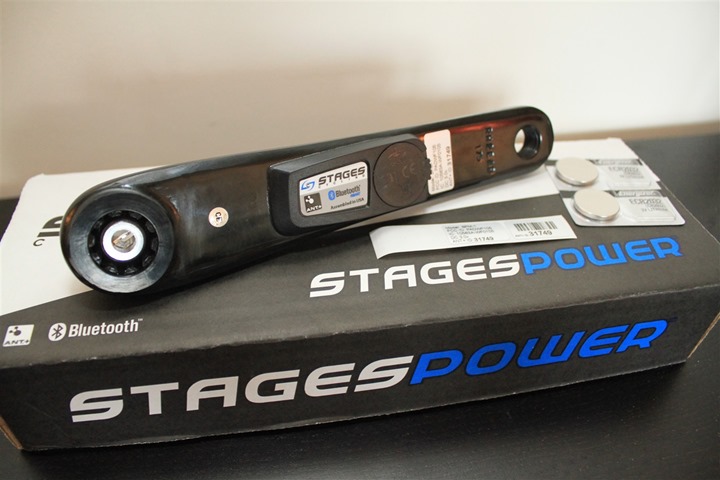
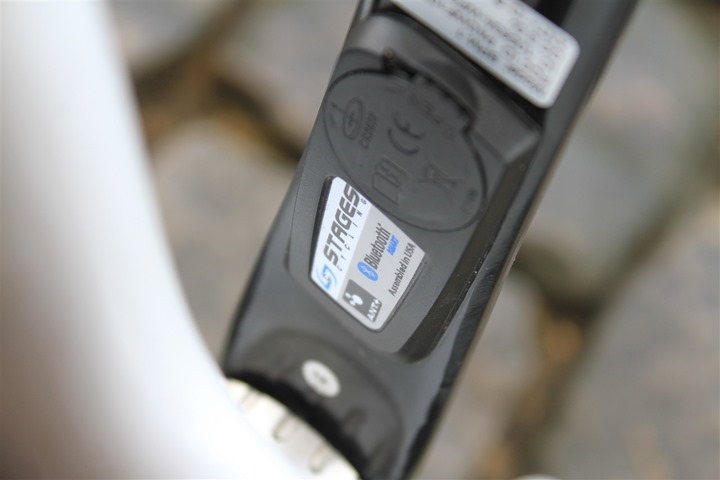
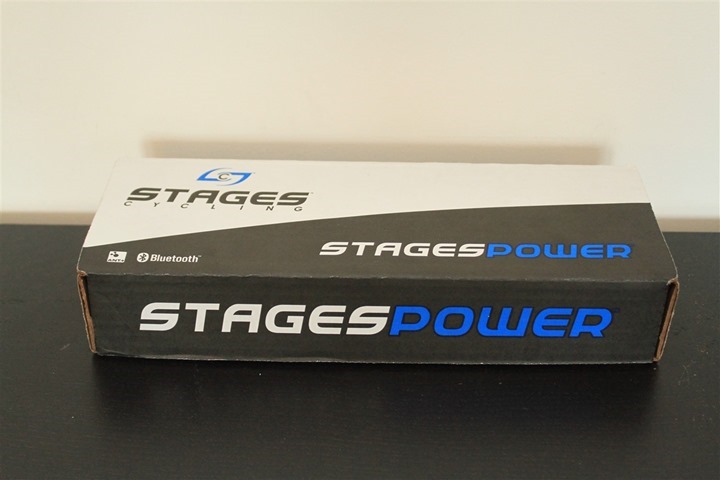
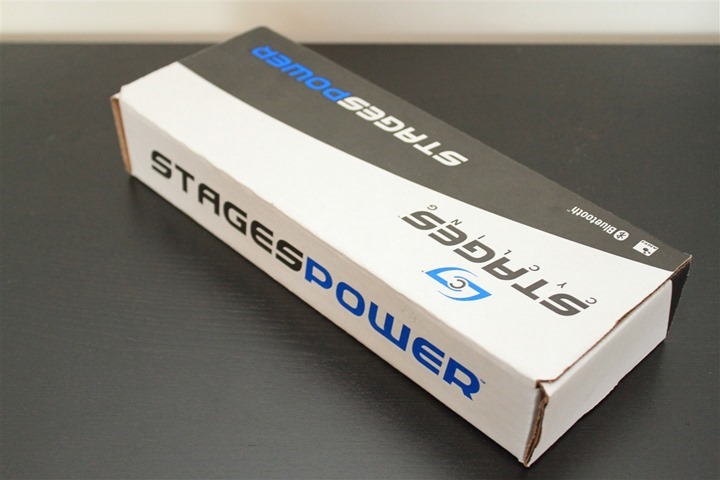
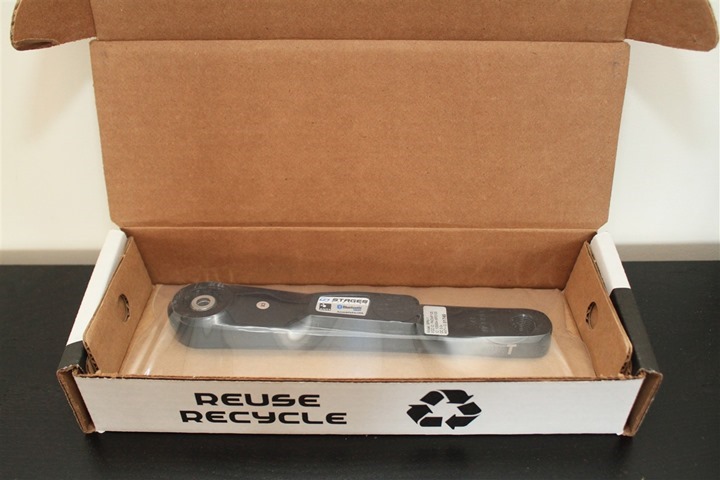
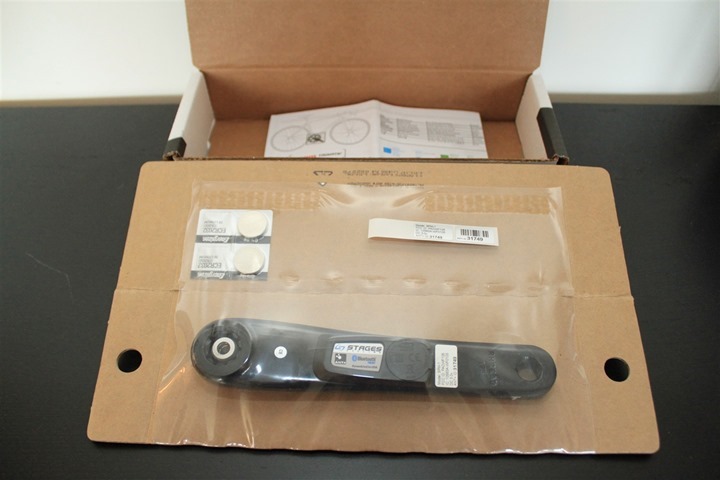
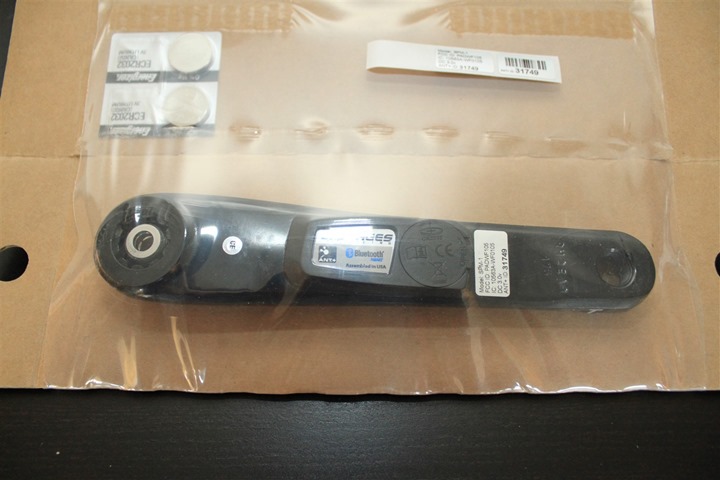
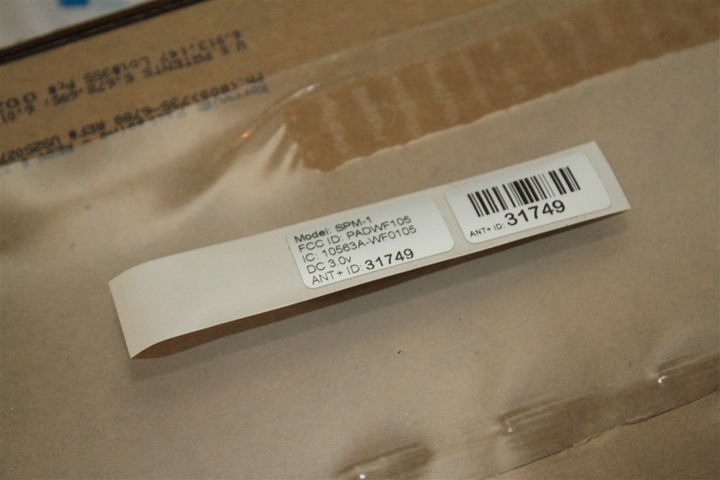
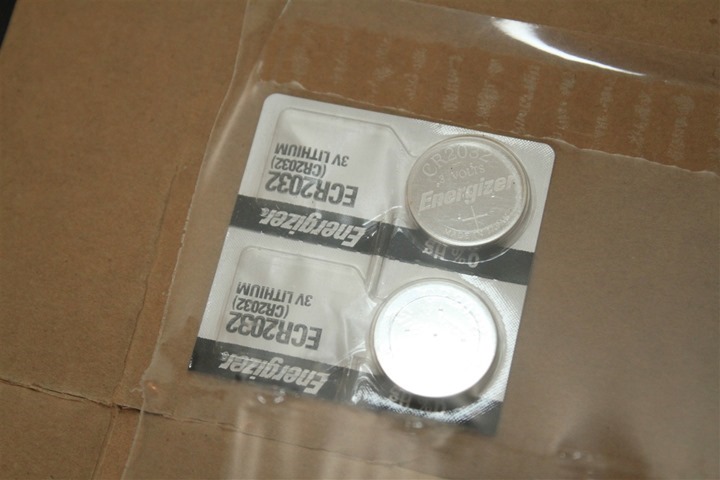
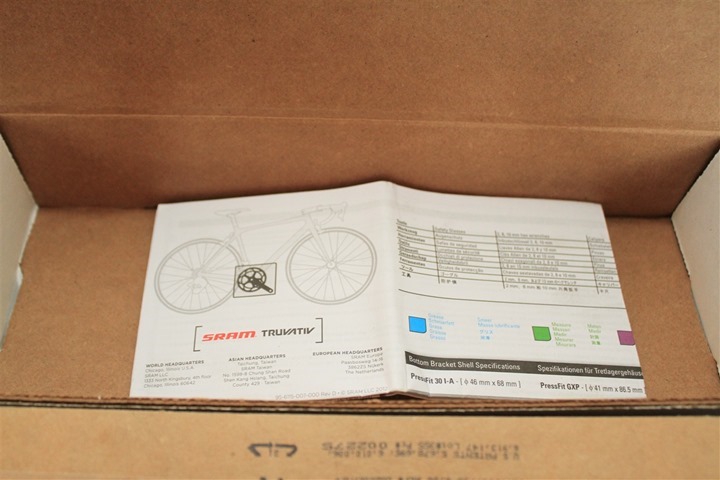
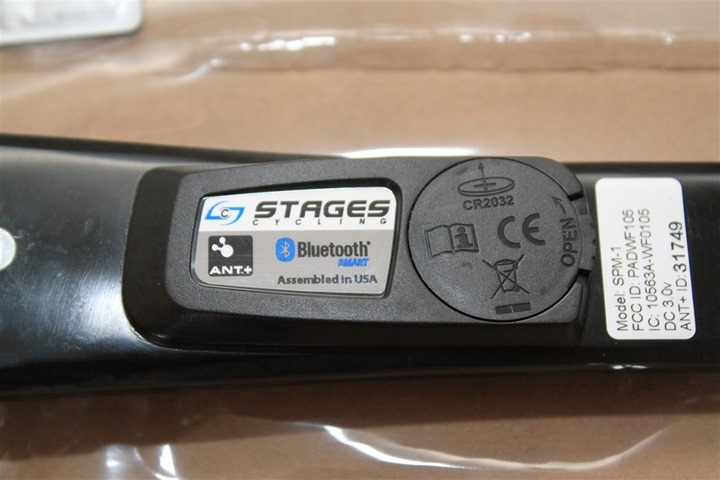
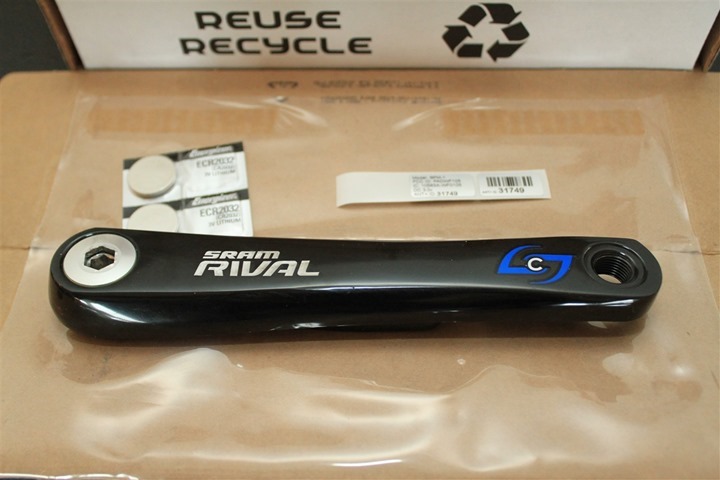
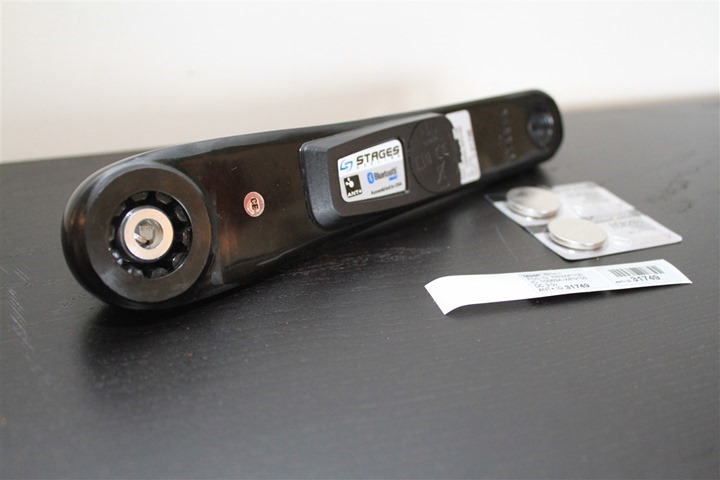
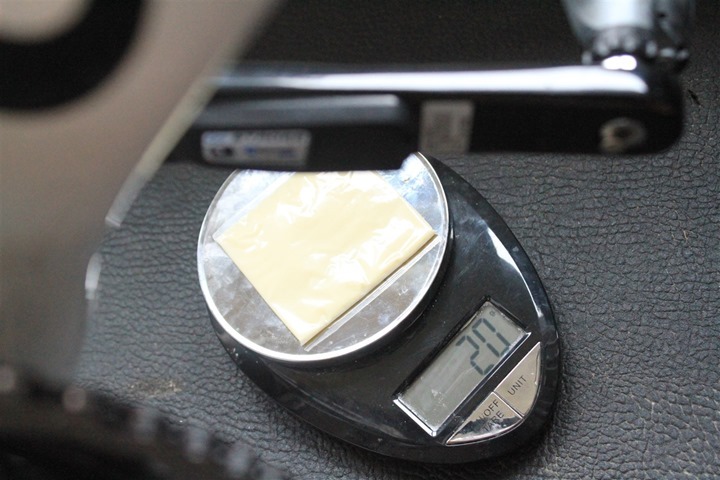
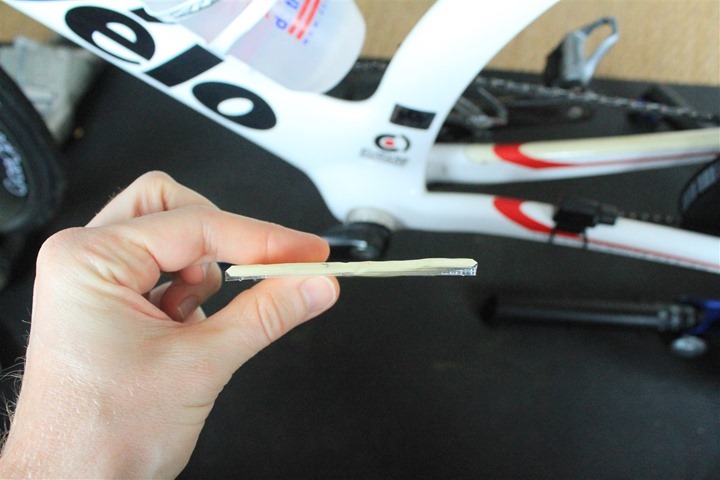
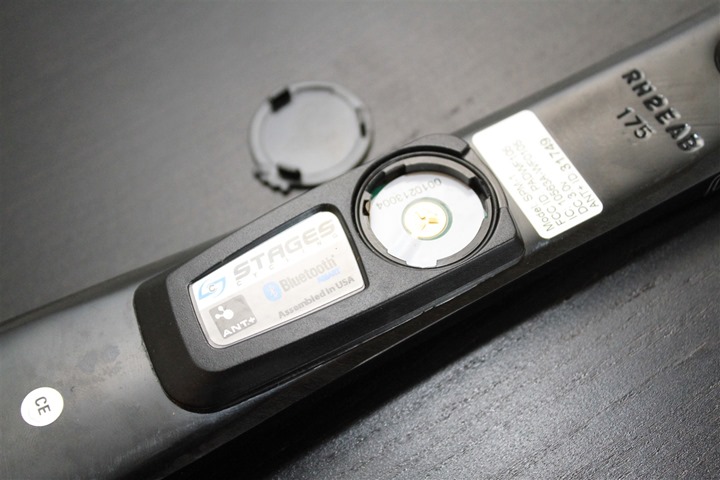

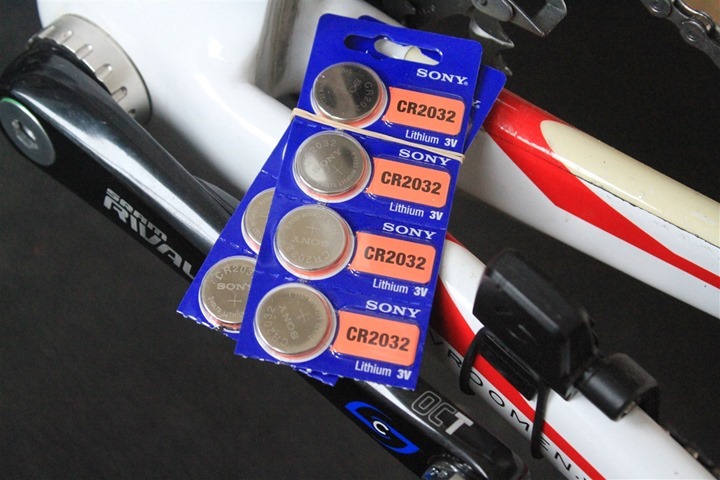
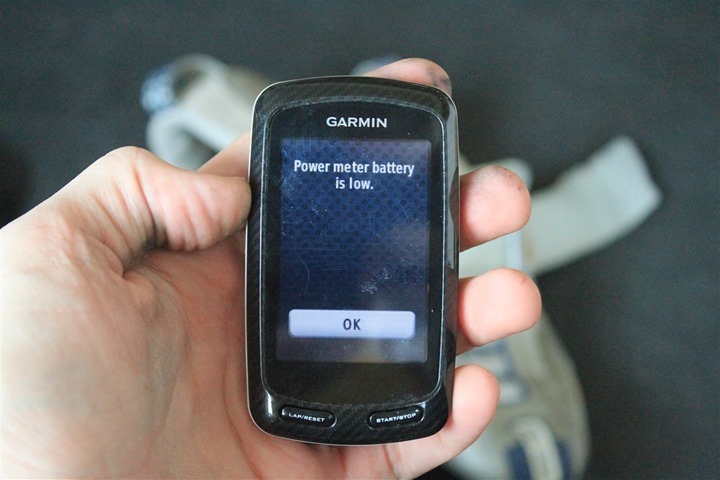

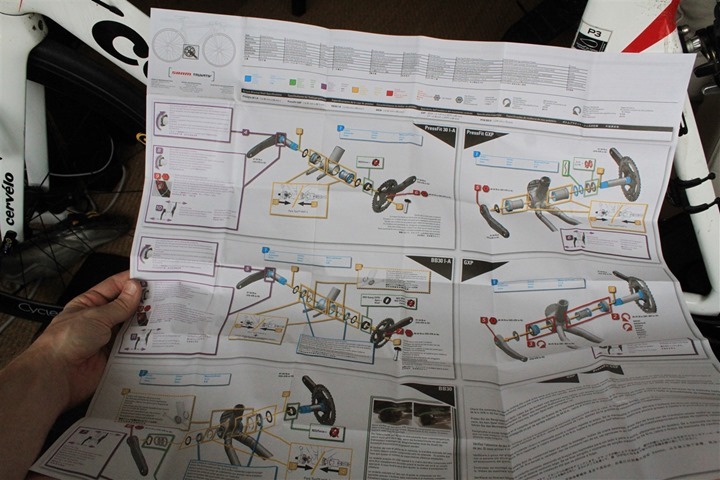
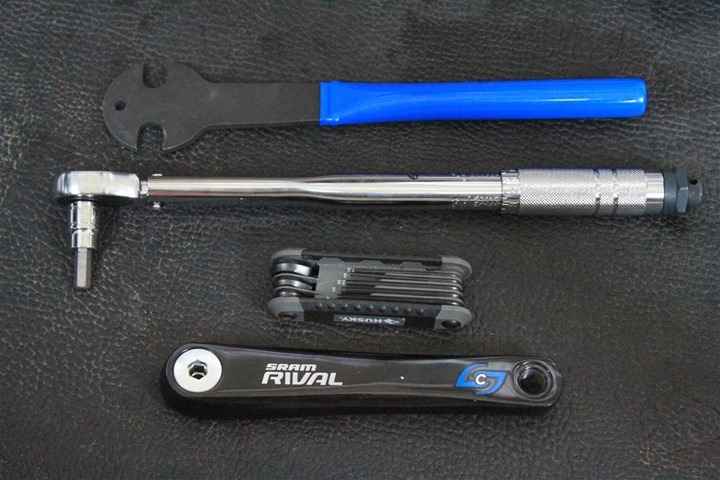
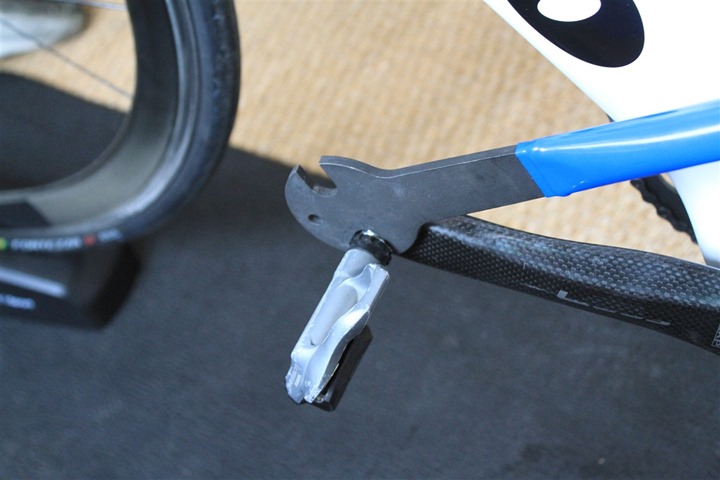
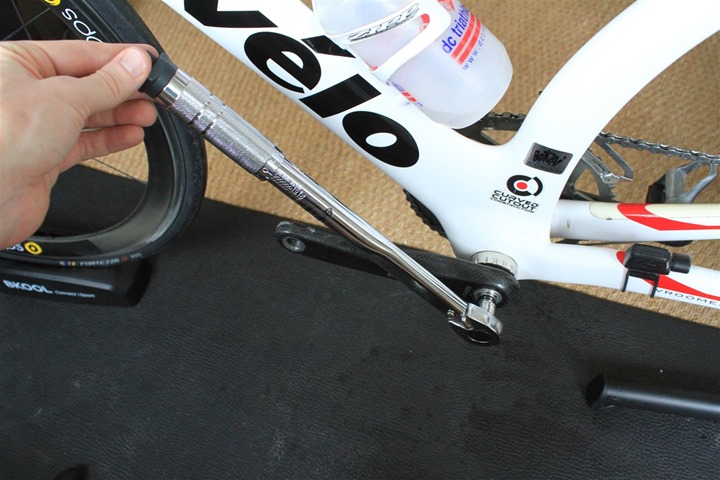
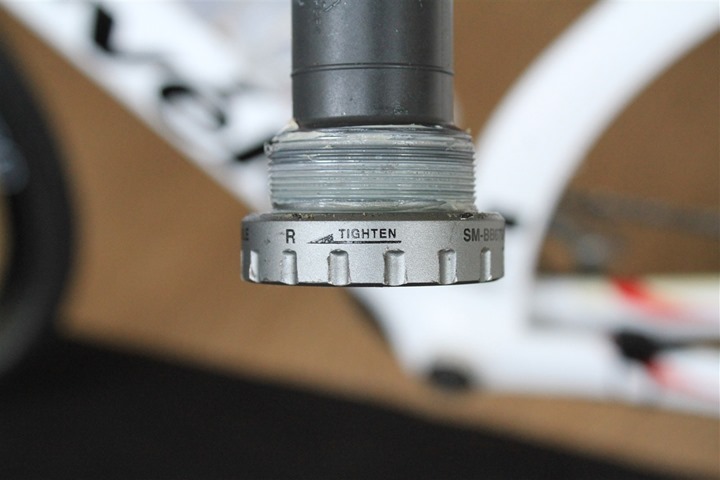
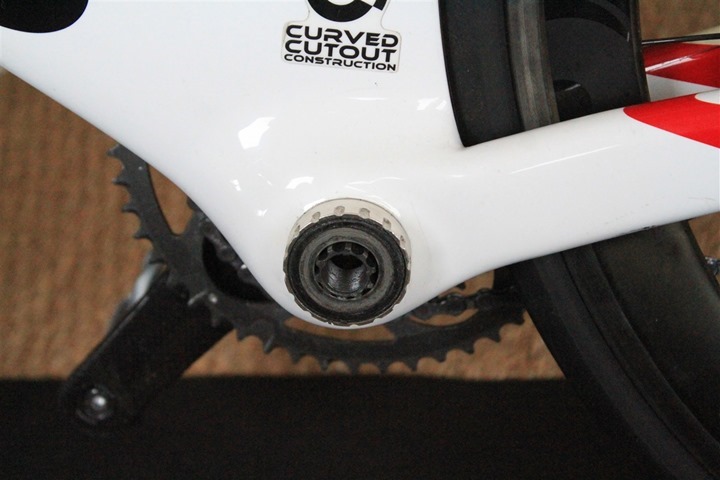
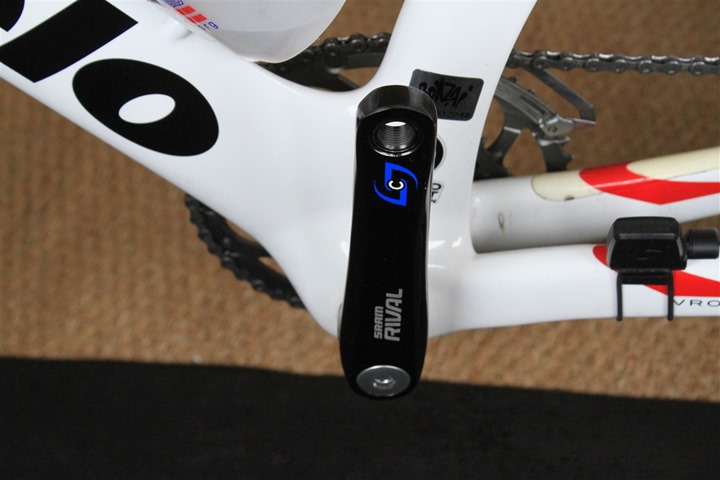
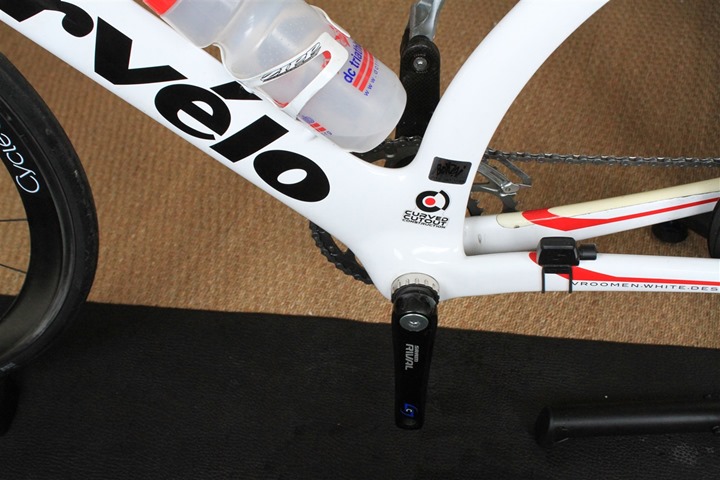
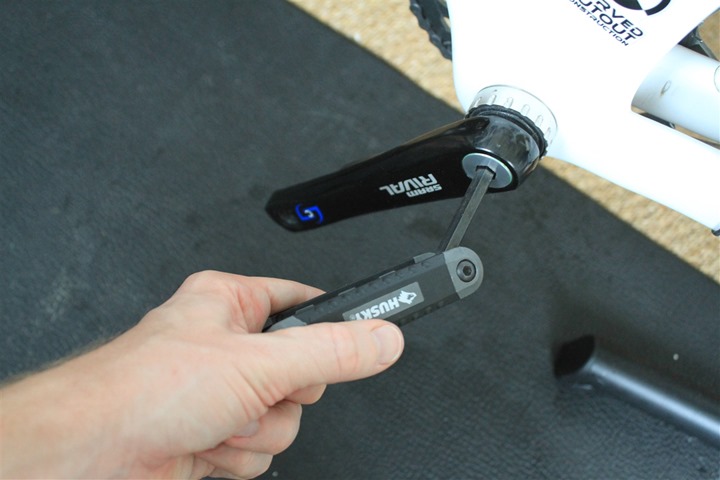

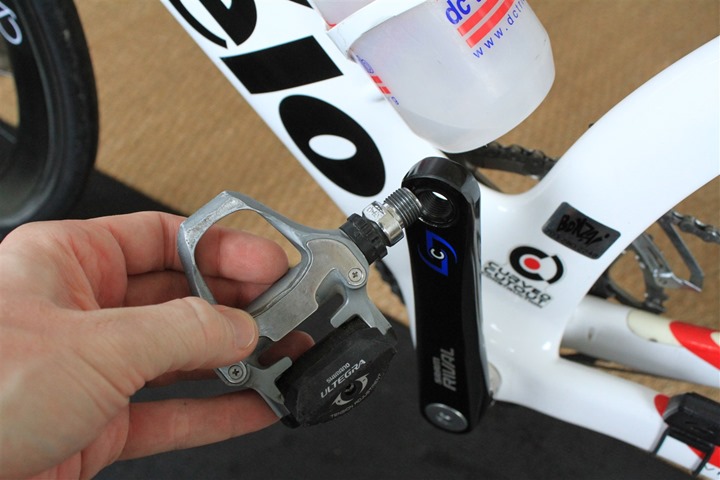

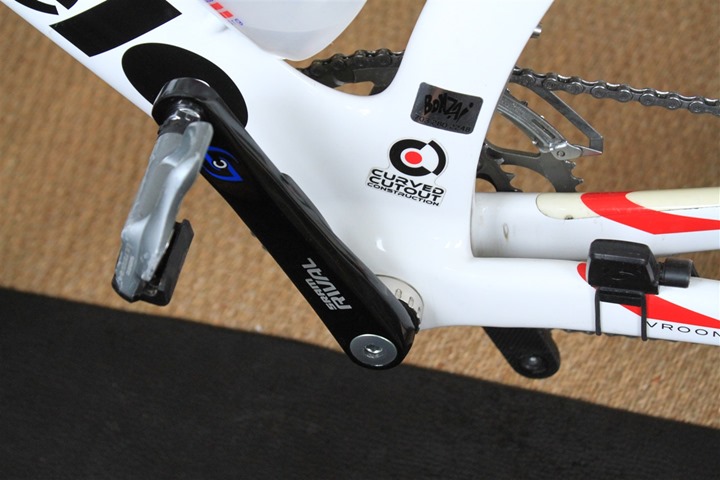
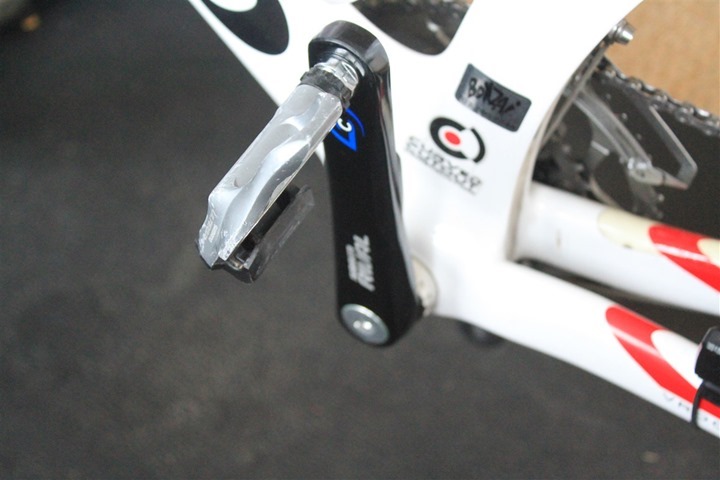
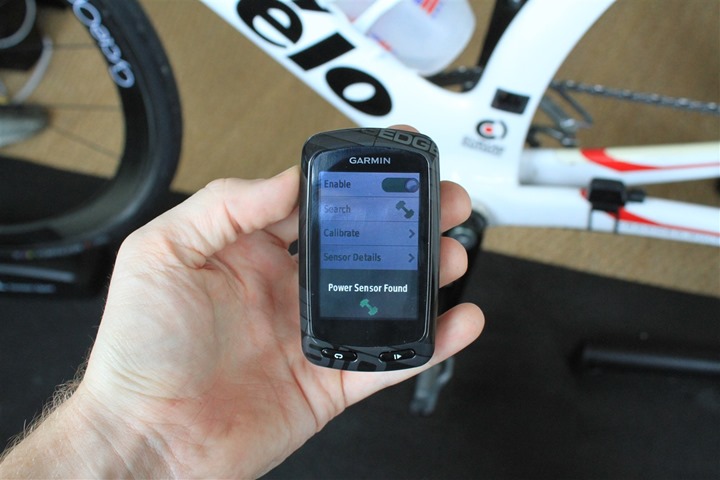
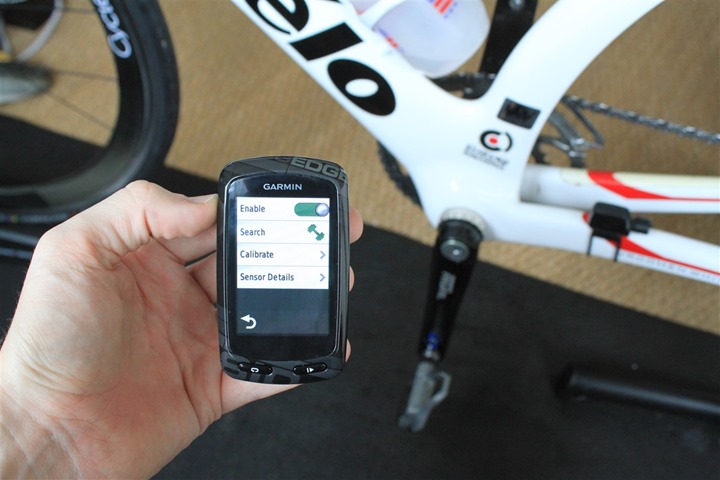
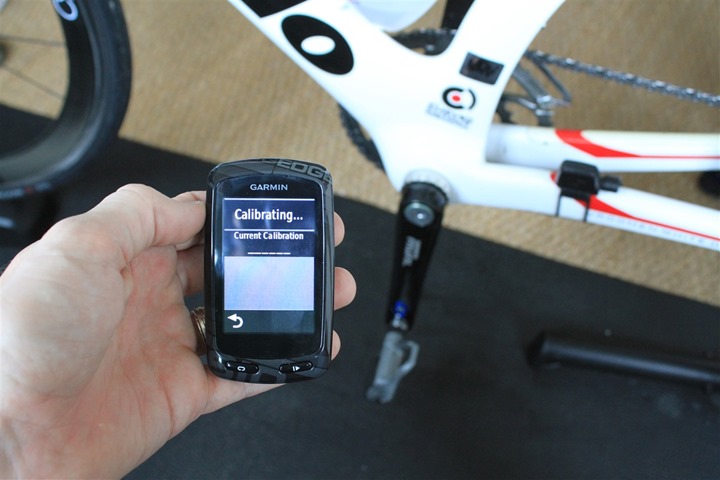
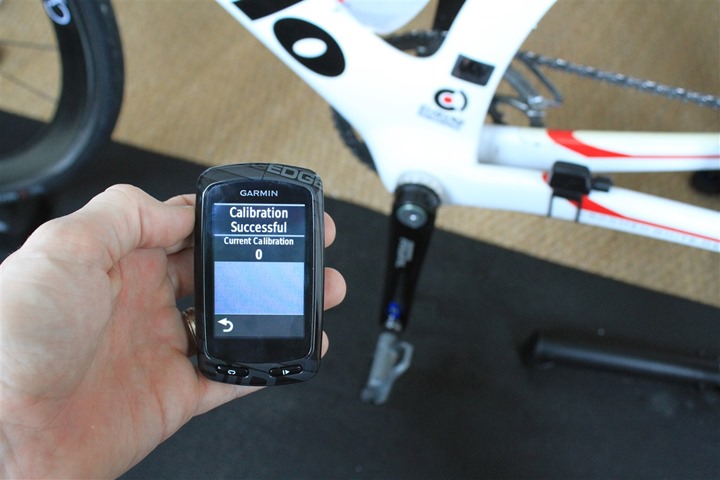

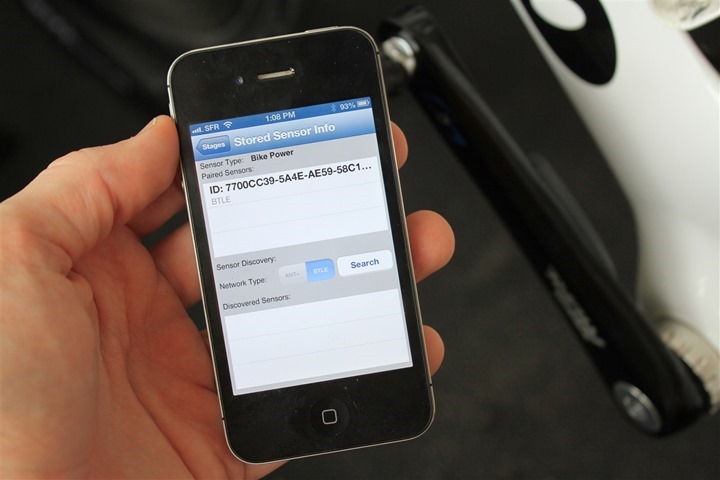
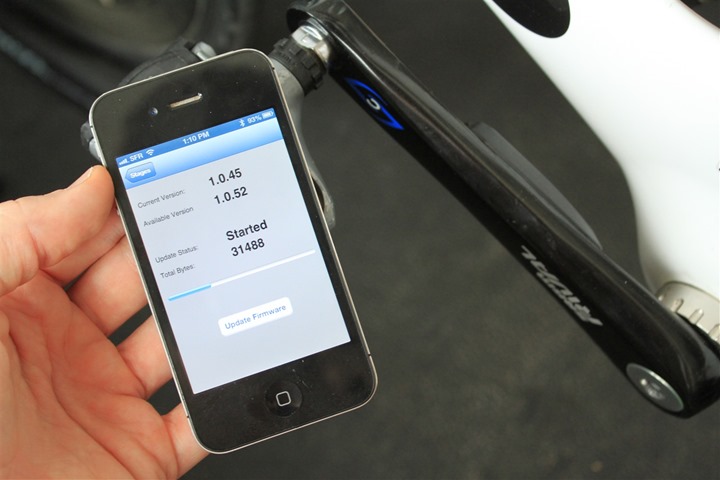
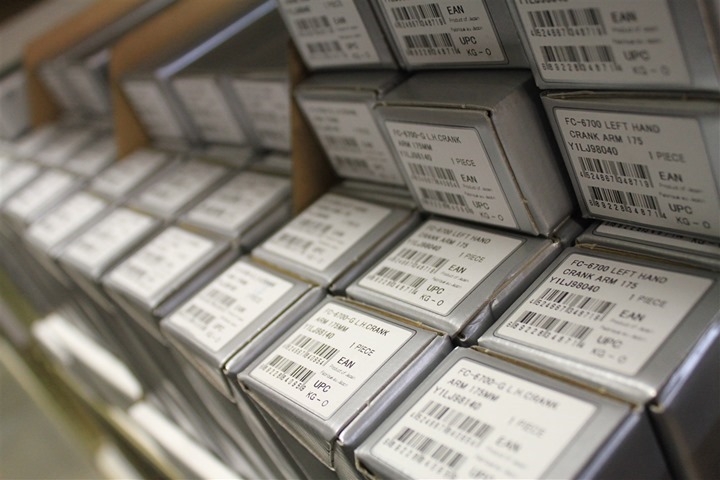

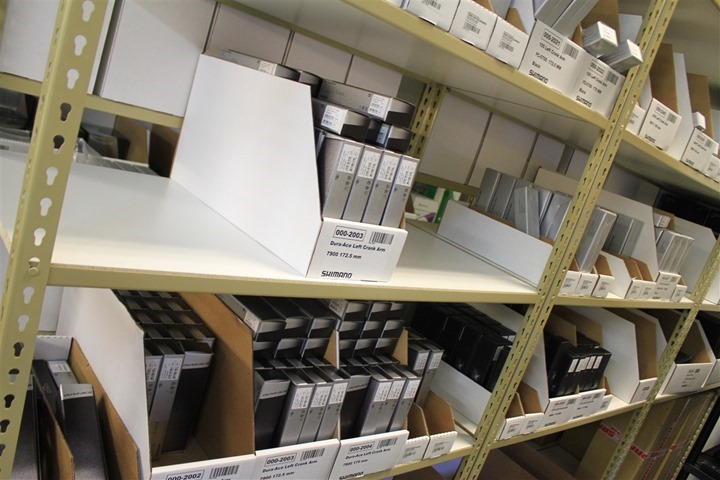
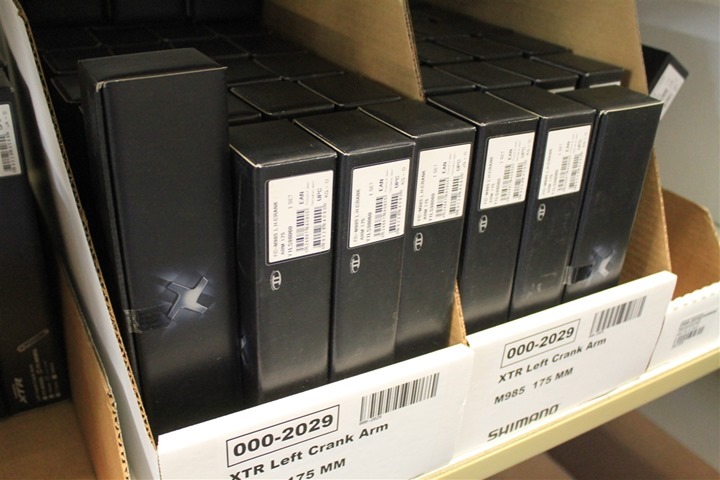
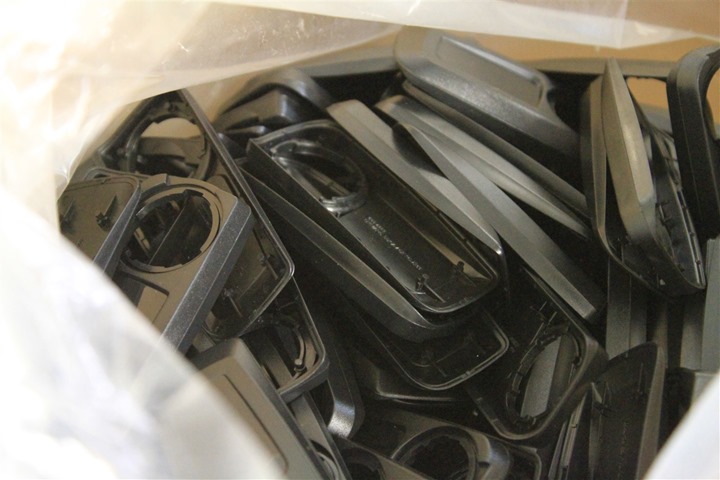
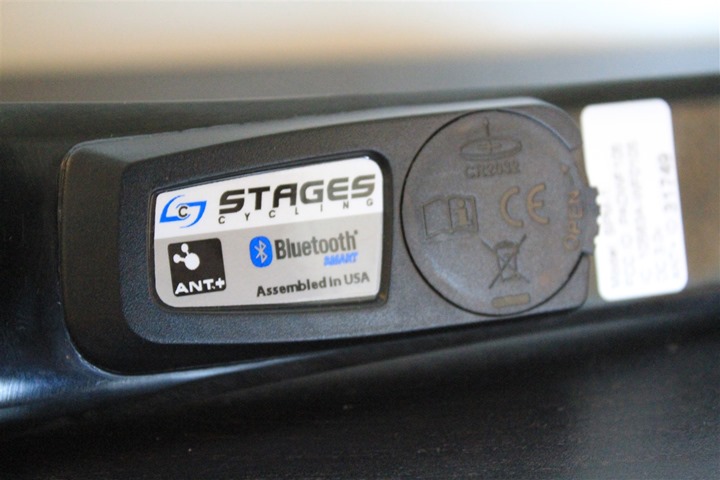
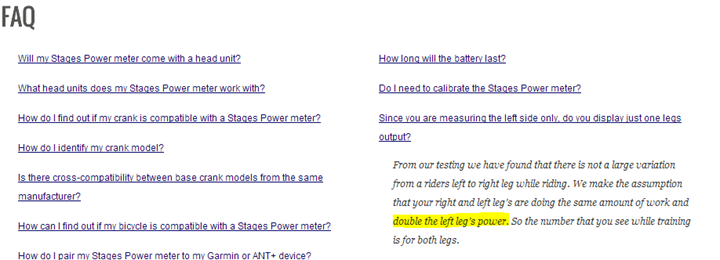

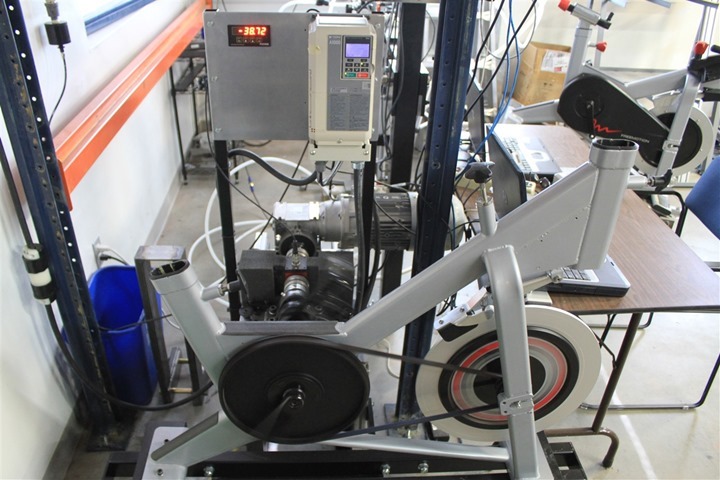
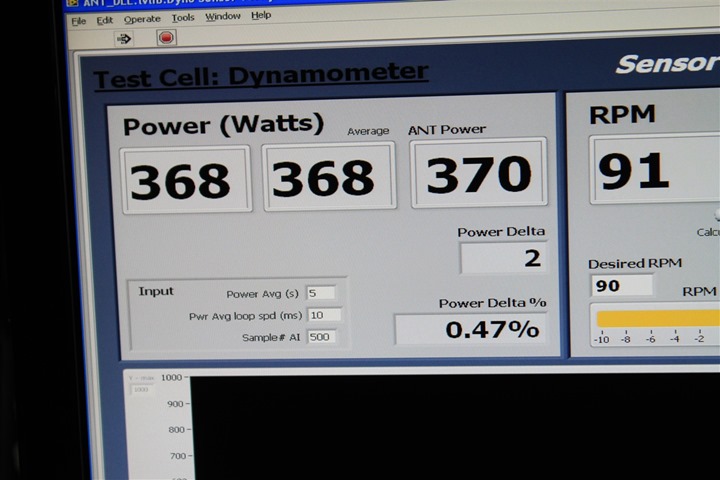
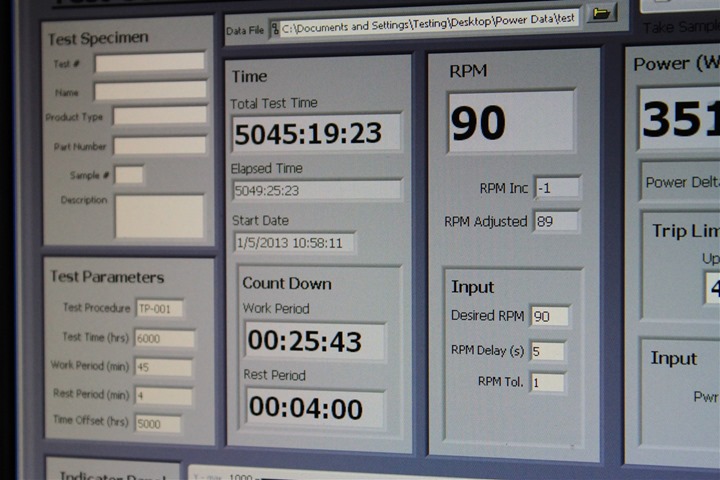
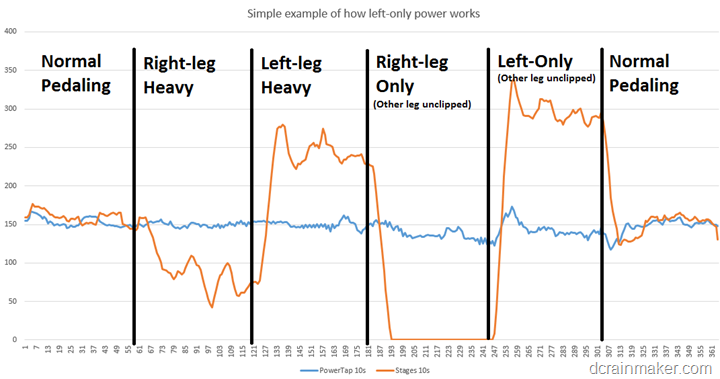
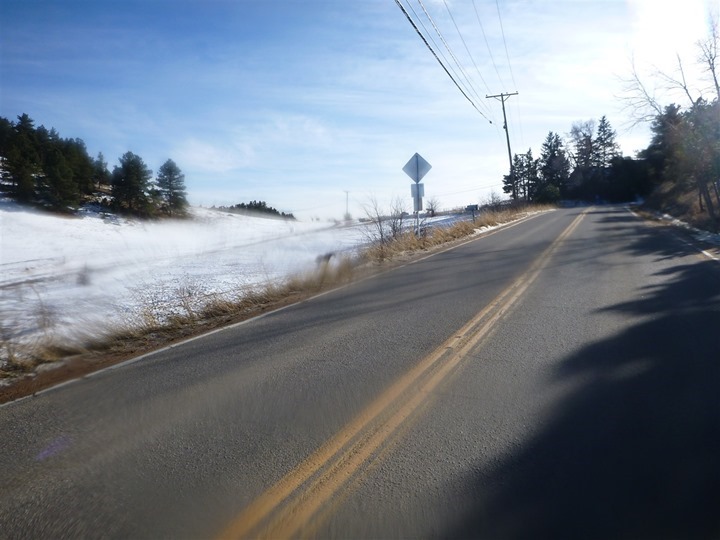
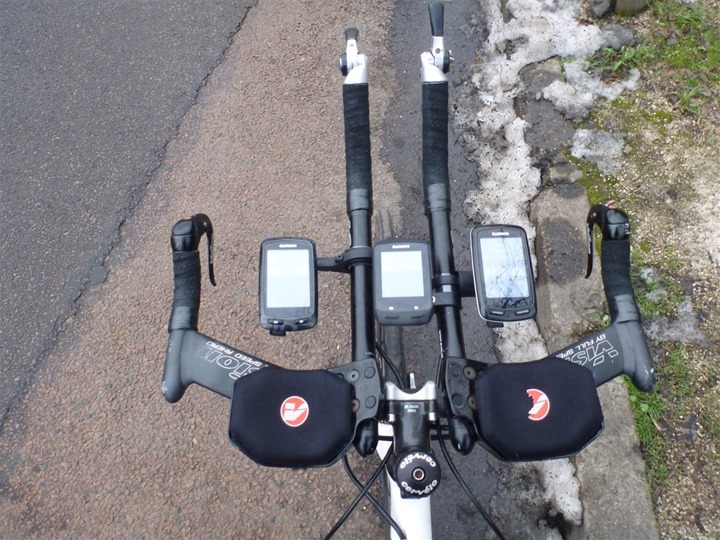
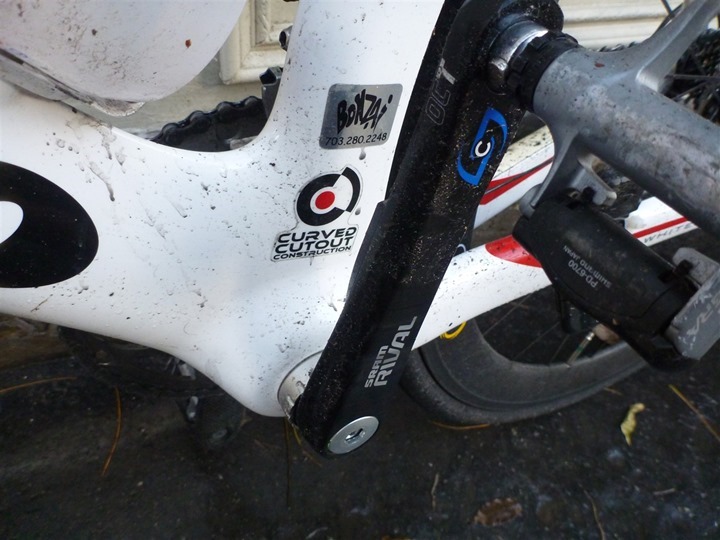
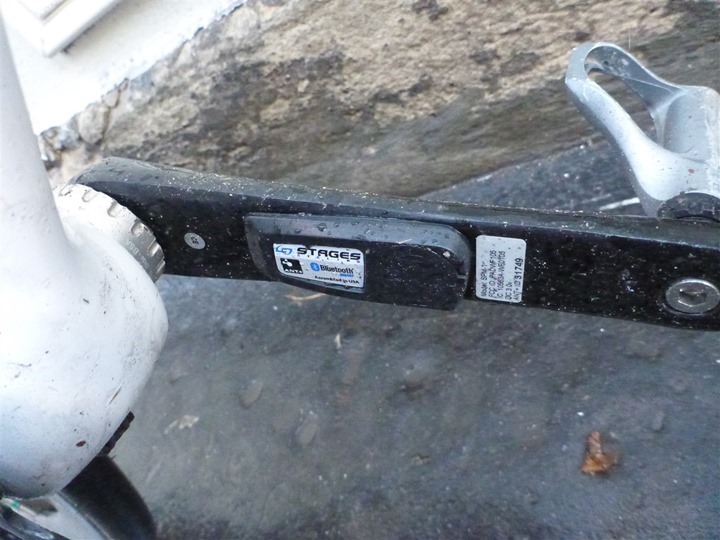
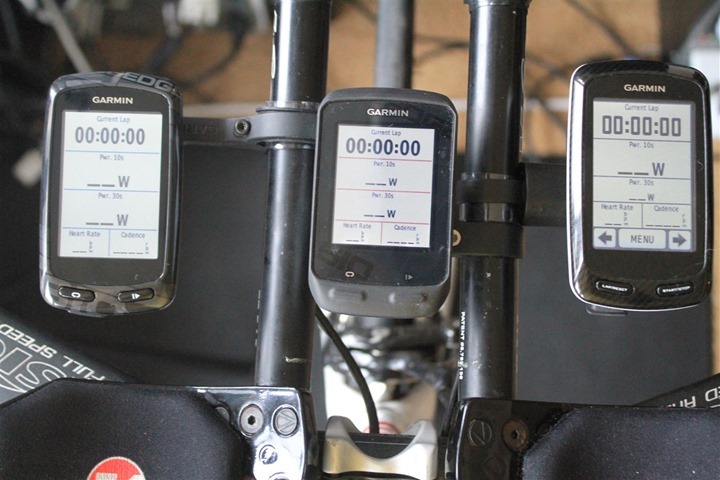
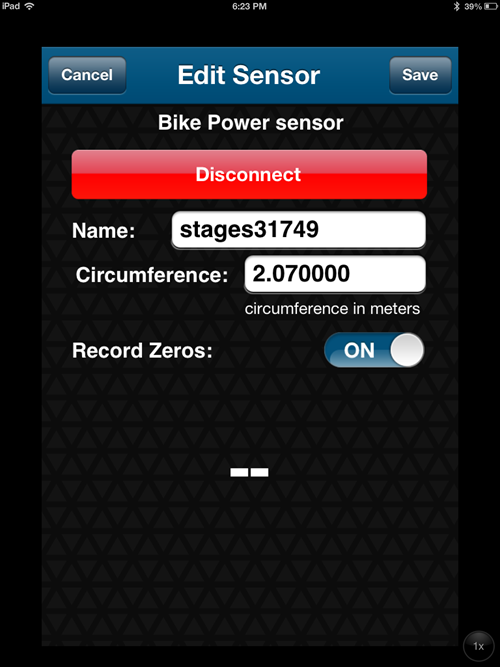
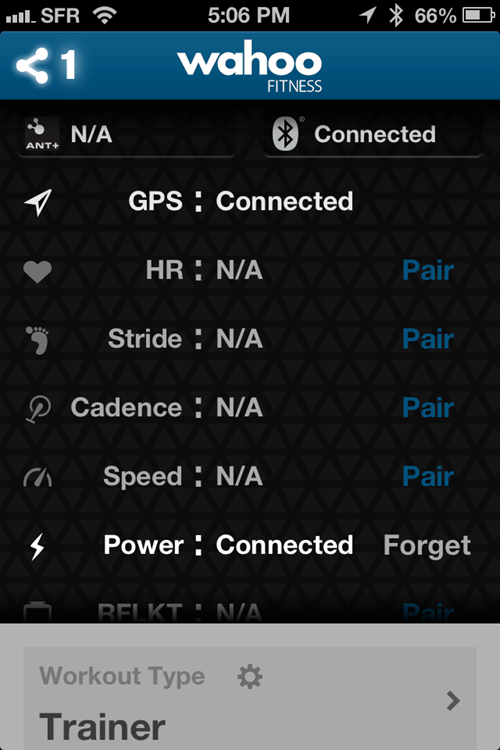
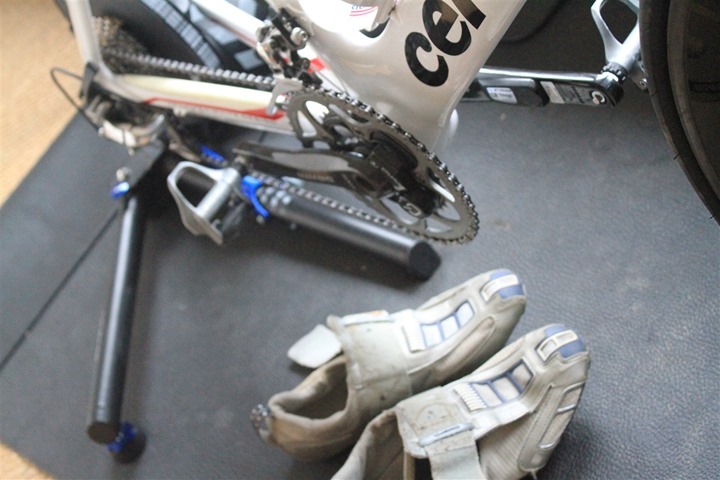


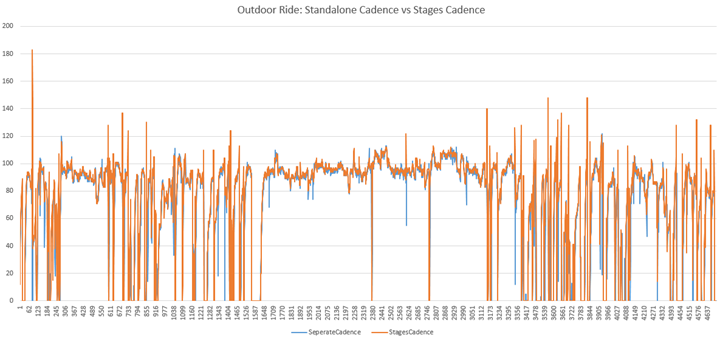
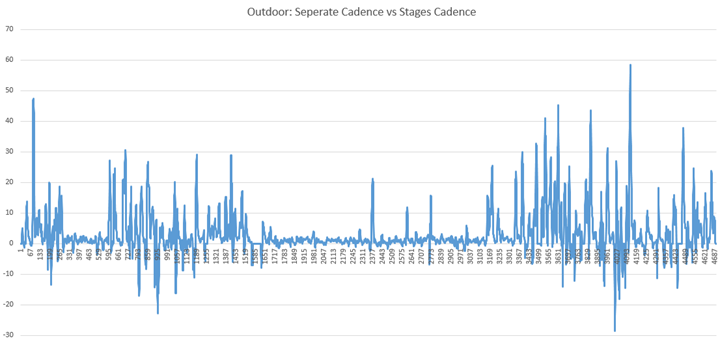
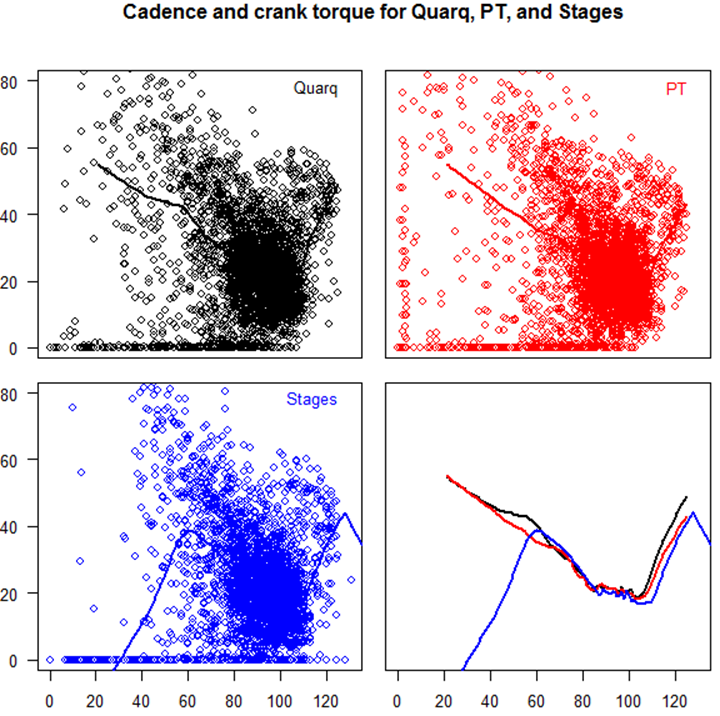
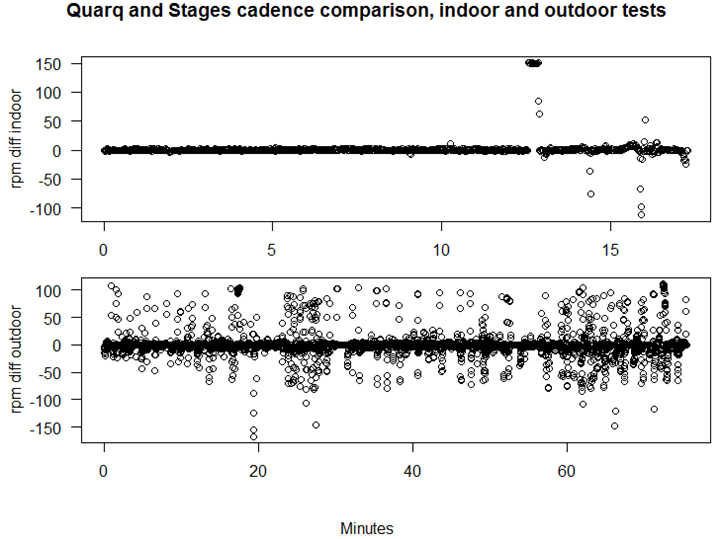

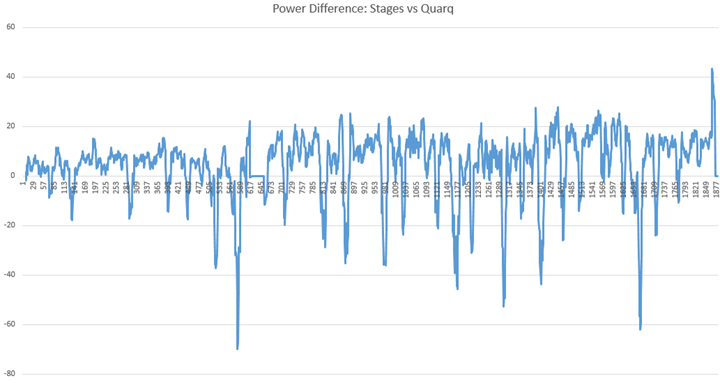
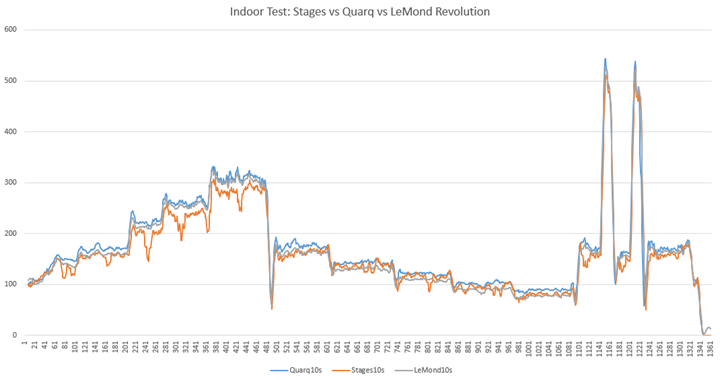
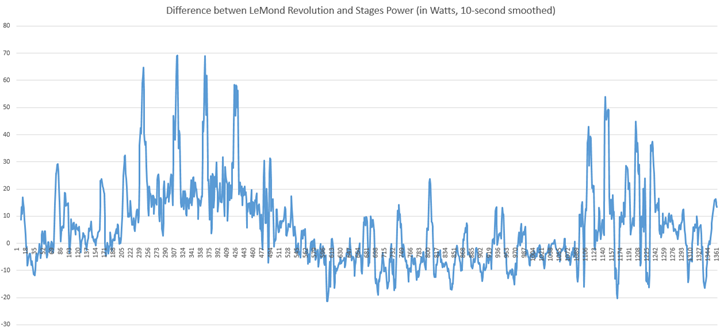

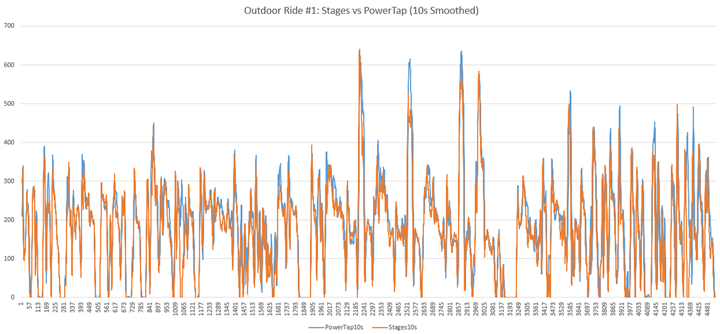
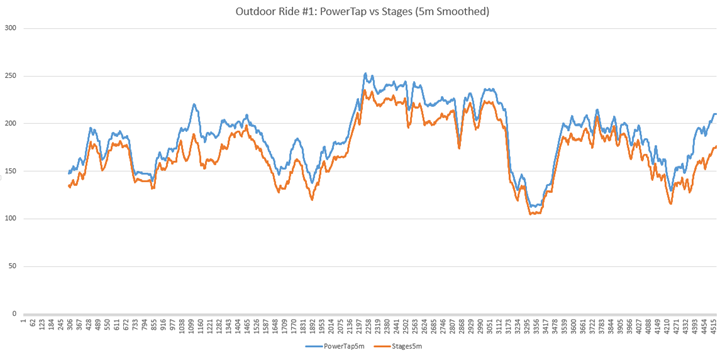
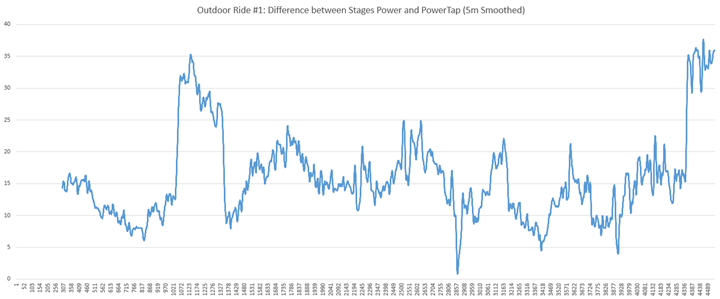
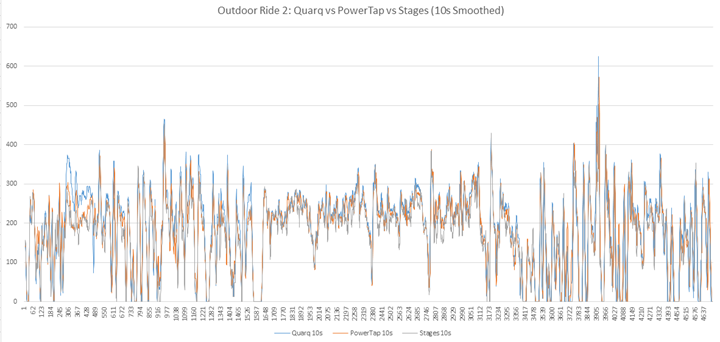

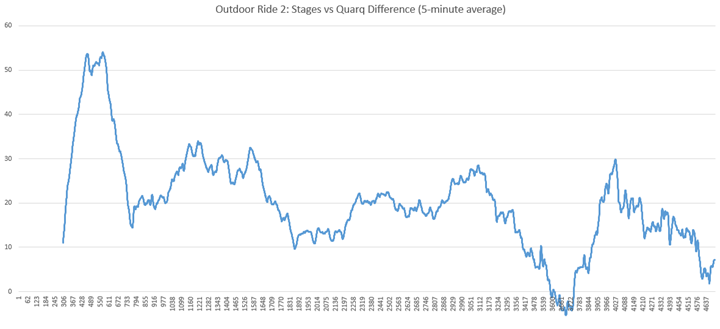
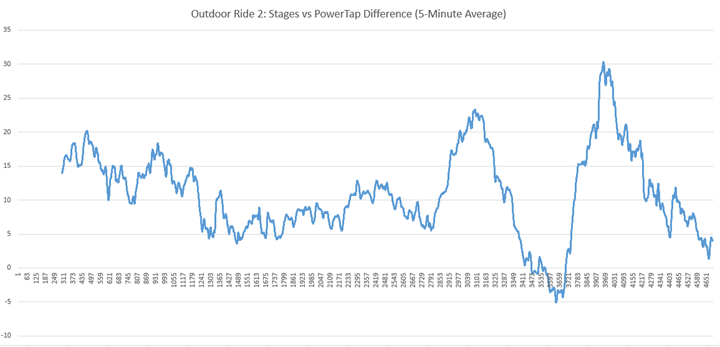
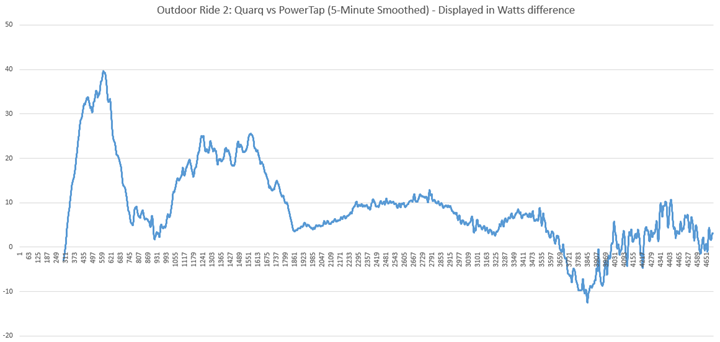


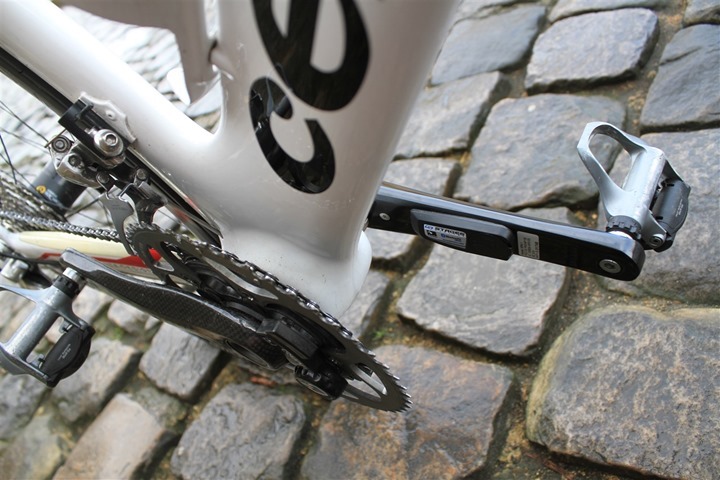





















great review (love the cliff!!!)
It is also does not work with carbon fiber crank arms, correct?
So those of us given a FSA crankset won’t be able to add a Stage power meter without buying a new crankset as well.
Correct. I talk about this a little bit in the section with the photos of the computer screens and build process. Enjoy!
No you will be able to use a matching aluminium NDS Stages crank arm with your DS spider and arm.
Been very curious about this for a while, thanks for the review.
One of your best reviews. Loved the American cheese slice weight comparison.
Great review as always. So it looks like I’ll keep waiting on the mythical Garmin Vector……..
Good luck with that…
Bummer on the results, I’d like to see more consistent data… the “pulses” and variability just looks rough.
I have a PT but was hoping this could be my next PM… maybe a P2Max or Quarq is on the horizon instead :)
In your review above you made very clear comparisons of the deltas of the Powertap to Stages and Quarq to Stages but no delta comparison between Quarq and Powertap (understably so as the review is about Stages).
We’re much anticipating the arrival of the Kickr. My g/f and I each have a power meter. She has a Powertap G3 and I the Quarq. I understand it’ll be easy for me with the Quarq to relate my trainer effort to pacing on the road and during races. However, what do you recomend for my g/f where her power meter will be removed during her training sessions to accomplish the same training effort to race pacing relationships?
Awesome review. One big PRO I would add is the overall weight of the unit. 20 grams to get fairly accurate power calculation is absolutely insane. It may not be a big selling point to triathletes on a heavy TT bikes, but for the road market its a big deal.
Look at what the options were previously. Essentially a $2000+ crank system that 200+ grams or a $1000+ wheel based system. Most people I know had Powertaps and they ran them on their training wheels, but when it came to “events” they would put on their good wheels without power calculation since the wheel was 400+ grams heavier.
For the cost of a low end powertap laced to cheap wheel you are getting power calculation with only a 20 gram hit. Are the current nuances in the data going to matter to 90% of the user base out there? Probably not.
As someone who has been waiting forever on Garmin power pedals I’m going to preorder this unit despite the data irregularities. I get to run whatever pedal system I want (in my case real Look keo blades rather than some knockoff) and it doesn’t have the goofy look of pods hanging from the pedal.
What am I losing going with the Stages vs. Garmin Vector?
1. Left/right power (which has dubious training benefits)
2. The ability to easily attach the unit to any bike. (I’m probably going to standardize on one crank model for my two primary bikes)
I don’t know if the Vector will provide more accurate calculation, its hard to say since the product does not really exist yet. I would imagine that they Stages unit will get more accurate over time and supporting both ANT+ and bluetooth makes it future-proof for the foreseeable future.
The one thing I will definitely lose with the Stages is having 100% confidence in the power numbers but I think its worth the risk. Honestly, most of the people I know with PM’s do not regularly calibrate so they are not getting 100% accurate numbers anyway.
Did you look at the data? Precision across a ride is around 10% peak-to-peak variation. Is that “accurate power?” I’d get an iBike instead.
Ray – great review as always. It would be helpful if you could share results of a few power based workouts, or a race with this and another PM. For me, I realize the limitations here (left side only) but I’m looking for an affordable and convenient PM for my MTB and not as a replacement for my road bike… I realize the Stages may be off up to 40+W at a point in time but it looks from your average results are pretty close. I’m interested in avg power for the course of a 5-20 minute interval, a few 10-15 second bursts, and comparing IF over a workout/race.
If you don’t calibrate your pm every time you use it then why have one in the first place? And again if you don’t mind power numbers jumping all over way more than say the quarq then why buy one?!? Consistency and reliability are a must when spending the money to train with power. Otherwise you should save the money and train with heart rate.
In the tests against the Lemond Revolution trainer and the Quarq, were you using a Lemond Power Pilot to measure power output from the trainer?
Yes, correct.
The one thing I’d be really interested in seeing here is a determination of how much of the error is caused by the left-leg-only part and how much comes from other areas. If the Quarq crank you used has power balance, it might be possible to figure out the left leg power from it and compare that in a spreadsheet/Matlab/etc. (ie Quarq power * left leg percentage compared to Stages/2 at each sampled point). Naturally, the catch would be if the units are doing any kind of smoothing that could obscure the accuracy of those comparisons.
If the main weakness is the simplistic method of filling in the right leg power rather than an inherent flaw in the design then firmware could do wonders for this device. When you apply power to the pedals, the cranks will accelerate – using the accelerometer they already have on board to compare the acceleration on the left vs right could be used to interpolate the missing data more accurately. That is, use the left leg power and acceleration to ‘calibrate’ power:acceleration, then measure acceleration on the second half of the stroke. Naturally, if gearing or load change mid-stroke you’d have some error, but at 90rpm we’re talking about short time windows. The implementation would be tricky and it’d require some complicated calculations, but I have to believe there is a better way to handle this than simply doubling the left leg power.
If, however, the error is coming from somewhere else than the accuracy will be more difficult to address. In most other DFPM implementations, the strain gauges are measuring deflection in a part specifically engineered for that purpose. Here, however, they are measuring deflection in crank arms built by other companies without the intention to be used for this. I’m sure they’ve characterized that part well, but not having control over it’s design and fabrication adds extra constraints their engineers have to work around (which typically mean compromises have to be made in other areas). Measuring power going through another part vs. power passing through the sensor itself is always going to be a good deal more complicated.
Going back and reading that I worded things pretty poorly :OP What I should have said is when you increase/decrease power to the pedals they will accelerate/decelerate, so you should be able to extrapolate changes in force by measuring the change in angular velocity.
If I understand you correctly this won’t work because inertia is hardly dependent on the pedal and crank mass. It’s dominated by the rider & bike and varies by gear selection. In the steady-state limit, for example descending while pedaling, the rate of pedal rotation is hardly affected at all by small fluctuations in power. And acceleration is a very noisy signal due to road vibration, etc. They have a trick to deal with that which I think is fairly obvious with some thought, but it’s not perfect.
I think your calculation approch could work in theory but I don’t think a firmware update will do it. The accelerometer is only meant to detect cadence so it only needs to know when it changes from pointing at the sky to pointing at the ground so it may not be that sensitive to detect where in the pedal cycle you are or the degree of acceleration. But even if that data did exist the amount of extra calculations that need to be done may not be possible with the processor on the crank arm as it is a very low power cpu.
I have done measurements with accelerometers to measure vibrations in the bicycle due to the road surface. When you’d ‘hit’ a speed bump you’ve an acceleration of more than 6g. That’s a lot when you’re doing peak detection on a signal with a peak of 1g (due to gravity). Easiest solution would be to add a gyroscope to unit, since a gyroscope simply measures the rotational speed. So no calculations have to be done and the amount of filtering necessary is very limited compared to just an accelerometer. Only downside is that a gyro consumes 3-6 mA and a accelerometer can be well below 0.5 mA. But there are viable solutions to keep the power consumption down.
You are sure making a hell lot of reviews on trainers and power meters lately, Ray…
Yeah, just the way the timing worked out. There’s literally nothing in the running pipeline right now, almost everything is bike-related (lots of trainers and power meters).
Wish I had more running stuff! :-/
Unfortunately, I don’t control product release schedules. In general, you see cycling stuff ahead of the spring, with running stuff ahead of the fall running season. Trainers were items I would have preferred be done sooner in the season, but time constraints on my part, and delays on various companies parts have slid that back.
Ray, is the software in the device end user upgradeable? If so what is the process? I’m curious if they do continue to improve the SW, how much effort there will be to roll that out.
Good point. Added section. Funny, I took all sorts of pictures on that, just never made it above. Enjoy!
The next step would be a long-term test, like 6 months. Using this for training, I don’t care if it tells me “250” or “220”, as long as its consistent from workout to workout. If those number go to “270” and “240”, I’m still seeing a 20w improvement, right? Other than in race pacing, it seems like it’d be a good alternative, again, assuming constancy workout to workout.
Welll…. reading the review and the deltas to other power meters (even with 5m smoothing), seems like it will NOT be consistent, right? It could be displaying 40 watts more than power meter X for a few minutes and then drop to displaying the same.
Looks like a beautiful product… that doesn’t work.
Ray, as always, a great — and by that I mean terrific — review. Wish I’d known you were in Boulder; would have been glad to join you for a run or ride.
Love the executive summary. I guess I don’t mind spoilers, and it really set up the rest of your very detailed analysis.
As far as accuracy, it seems to me that RELATIVE power accuracy is more important than ABSOLUTE, cross-platform accuracy. That is, whatever PM one is using, the real benefit is tracking individual progress over time. What do I care if a 180-pound masher can pull 300W on his Quark and that I can only maintain 200W. Given that I’m much smaller (about 115 pounds), my power:weight ratio may be better. But in any event, why should I care about comparing absolute wattages with teammates, rather than establishing my individual baseline power output (especially over a course that I routinely ride) and comparing my improvement/decline over time? Or am I missing something?
Thanks again for all your great efforts. They are truly appreciated.
If 2 power meters are CONSISTENTLY off relative to each other, then that’s just a problem of scaling the one that is “off” to read correctly (i.e. it’s just a torque slope calibration issue), which means that there should be NO reason why they can NOT read similarly.
The issue is when they are NOT consistently off relative to one another, which is what Ray’s plots above show.
Lastly, accuracy and precision are important when you consider that you MIGHT want to use the power meter for other purposes (i.e. field testing of equipment) and also that a given power meter may NOT be the last one you own. Not having good accuracy makes comparing power files across your power meter history a bit difficult.
The argument of “I don’t care if it’s off as long as it’s consistent” is very short-sighted. Especially considering that if a power meter is consistent, then there’s no reason it can’t be accurate as well.
Relative power is certainly the part that’s important, but the problem here is that Ray’s data seems to show that the difference between Stages and the other meters isn’t consistent. If it always read 5% higher than the other meters, for instance, then it’s fine as the numbers it gives you from ride to ride should be comparable. If it reads 5% higher at one point and 5% lower at another, then even if you do two identical rides you could get completely different numbers.
The tricky part with reading just one leg is that the quality of the data will be dependent on the uniformity of the rider. If your balance is 45/55, for instance, and you maintain that balance all the time then the numbers should still be comparable. In an absolute sense they will be 10% low, but they will always be low by a fixed percentage so relatively speaking the data will be sound. The issue is that if that changes over time (eg form breaking down as you get tired, seated vs out of the saddle, aerobars vs base bar, redlining versus cruising, etc.) then it could introduce variable degrees of error into the data. How much of an effect that has is the big question, and the only way to know that would be to study L/R balance of a large sample of cyclists.
Either way, this looks like an intriguing product and if the above issues come from the single leg measurement, it is likely something that will be improved over time.
Too bad. I’ve been looking forward to this for months. Accuracy is very important to me so it looks like I’ll have to look elsewhere.
Thank you for an excellent review! I’ve also been looking forward to this review and the potential of getting one of these units. While it is left-side-only, it is very reasonably priced and would certainly be able to create reliable measurements (accuracy aside). However, looking at these results I’m not convinced…
It would be very interesting if Stages could comment on these findings, and if the accuracy issues can be addressed with firmware updates. OR, is this an inherent problem with using only one strain gauge (when for example SRM uses 8 and P2M 4 guages)?
They don’t specify exactly how many gauges there are (and they wouldn’t while I was there either) – however, they do seem to imply there are more than one. See this image that was distributed by them to media, regarding their strain gauge array: link to sites.google.com
Where did you find American cheese in France??!! Quelle horreur!
It’s in every little grocery store, though, they don’t call it American cheese. Just cheese. Tastes the same. :)
Like Titan, I’ve been looking forward to this for months, and have a preorder in. I don’t care about accuracy overmuch, except that this sounds like it is inaccurate enough to scare away even me. I mean if similarly-situated intervals can be +/-20-40 watts, that’s the difference between different effort types that I’m trying to stay within. Plus, if it’s not consistent (or at least predictable) in its inaccuracy, then I’ll have a real problem comparing one workout to another. I would like to see Stages respond, but maybe that isn’t how Rainmaker’s reviews work (might be a can of worms he doesn’t want to get into). I guess I’ll have to wait for the 6-month update or whatever to see if they can get this sorted out.
Companies are always welcome to respond, publicly or privately. Most (actually, all I think) tend to, usually privately first if there are any technical corrections (misinformation listed). Publicly if there’s something they’d like to note.
Ultimately my goal is to increase conversation between consumers and the companies that make the products, I don’t think more discussion is a bad thing.
As has been suggested by Tom earlier it would be nice if the Quarq was able to separate the left and right legs into 2 power graphs and then you could do a true direct comparison.
Failing that it would be nice to hand it over to a fellow rider for a further series of tests to see if the inconsistencies are due to your weaker left leg riding style. Alternatively ask Stages nicely if they would consider doing a special test crankset with both arms equipped with a PM. you could then overlay the data and smooth it for a true reading.
Ray–have you used the Computrainer SpinScan software? From what I understand, it can provide data on left/right leg imbalances. Was that a consideration in your reviewing?
I have, but not in a while. I’d have to understand better how accurate that really is, versus estimation (it may be quite accurate, I just don’t know).
That said, I am looking at digging back through all my Polar/Look Keo pedal data from earlier this summer and seeing what imbalances looked like there. Just for curiosity. Off the top of my head, I thought I was usually 46/54ish (left/right) average on ride. But I’d like to look at difference scenarios and dive into a bit more. Additionally, it’d be interesting to compare that against both the Quarq RED and Power2Max data and see how the left/right plots look there (estimated Power Balance). Just need a few more hours in the day…
Can you get some Polar/Look Keo pedals and run them with the Stages, then try to correlate Stages power fluctuations with left./right balance changes?
I started looking at data from this past spring/summer when I was testing the Polar/Look units. I also looked at data last night from testing the Brim Brothers unit (does left/right support as well). Further, I started looking at calculated left/right data from my Power2Max rides.
It’s interesting, and there are some trends there that myself, Robert and Thomas are looking at (with respect to my leg balance). But we don’t have any coherent conclusions comparing those files (gathered on rides over the past 6-8 months) with the Stages files. Different rides, different days, different everything.
The question I would ask (the reviewer) is that, especially for a cyclist with no power meter and multiple wheelsets, would you recommend this at the sub $1000 level?
The data is suspect so no it’s not a good choice at the moment. For under 1k go pick up a powertap.
Even an ibike would be better.
It wouldn’t likely have mattered, but i plan on using this on two bikes with five wheelsets (one road, one cx). The NDS crank arm is what made me want this, i still think it would make a training benefit…
djconnel, how do you claim an ibike is better if that wasn’t being reviewed? Would seem like cross would be pretty hard for the ibike to get right
Randall, I don’t believe there is another option than the Stages Ray reviewed. All other PMs are above that price level I think.
This is a great review – a lot to take in. My question is this: does the unit provide the pedal location in raltion to power output in the ANT+ (or BT) data stream? I ask because a very useful training tool would be an audio head unit to provide a vairable pitch tone based on efficiency of the pedal stroke. Pedal efficient circles, and a pleasing hum is made. Pedal “squares” and an grating buzz is made.
If the data is in the stream, it is likely a trivial matter to program into a iOS or android application, and a BT headset can be used for audio output.
No, not at this time.
Im willing to give one a try on my roadie, I have a wattbike and know Im pretty consistently 50/50…. I have SRM for my track bike and TT bike… so as long as I have a number for climbs and warm ups (for track racing I use my roadie) this looks like something I will use and at the price point its worth a punt. Im curious about how firmware updates might be applied after purchase…
I believe Ray updated the review later in the day. You can now see pictures of how you can use an iPhone via Bluetooth to update the firmware.
You are comparing to a quarq that was giving unreliable data until you remembered to zero it out? Did you continue to zero out the quarq during your ride?
I specified above the steps I utilized to manually calibrate all PM’s at multiple points before and during the ride.
For the ride the Quarq was compared against, it was manually calibrated at 0 minutes and 26 minutes, plus any zeros that would have occurred during backwards pedaling while coasting. The PT was calibrated at the same time, plus auto-zero’s that would have occurred as well (it was enabled).
I like the Powertap because it measures Watts, cadence, speed, and distance, then the computer will pickup HR, W/Kg…
But it is interesting to see the Powertap is 5-7% less than the Quarq. I would guess that is the efficiency loss of the extra sprocket + chain + sprocket. Does anyone know? It seems the Quarq and SRM are the most accurate.
I think the real-life accuracies of both are sufficiently low that this isn’t a precise measurement of drivetrain efficiency. Drivetrain losses should be no greater than 3% according to most measurements.
For all your power meter reviews you seem to do a very good job making sure everything is calibrated. That makes me wonder, if a user is lazy and doesn’t do these calibrations outside of what happens automatically during a ride like auto zero while coasting how much less accurate will the power meter be? Do some really require it to be useful?
That’s actually one of the core strengths of the Stages system – more or less lack of calibration required or needed (compared to other units on the market).
And I saw that in my testing, the zero offset values varied by almost nothing from inside to outside and day to day. Certainly far less than other PM’s.
I truly do think that type of system is core to moving power meter accuracy on the whole forward (as an industry). And, to be clear, I don’t see the Stages calibration as a factor in the variability differences seen on outdoor rides (I think other issues are at play). Hence why I still like the calibration aspect of their system.
I wonder if the lighter weight (thinner) crankarms will produce more accurate results since they will flex more than a heavy weight cheap one?
I wonder if they can’t vastly improve the algorithm with one of the true L/R power meters. A study throwing 100 people on bikes for 10mins or so should produce enough data to pull out some simple info like if there is L/R hand dominant basis (which I think is the case)
Much appreciated review Ray.
I’ve been thinking/hoping this would make a good addition to my MTB, I use my PT on my road and Tri bikes, and – mediocre rider that I am – it bugs me that a Mountain ride leaves a blank for power when I upload.
Looking at your report and analysis however, this seems particularly poorly suited to MTB riding as the Stages unit is at it’s worst in dynamic situations. It had large, unpredictable margins of error with shifts in cadence and/or power levels which is exactly what a (good) mountain ride is full of. Same thing for a Crit or Track bike.
Let’s home the forthcoming storm of criticism stirs the good folks at Stages to solve for this somehow. (My theory – build a largish batch of dual-head units with R & L sensors – gather craploads of data that allows them to more accurately model the behavior from a single pedal. Also – cloning you to create clone army of riders able to execute 30 minute power protocols over and over should provide the quality data they need! :-)
Thanks for the well written review. I hope that Stage Power will be able to fix power accuracy as you have noted in your review. On a side note I was just wondering what type of torque wrenched you used to tighten the crank?
been waiting for this review, and actually been holding off on getting a power meter until this thing gets out in the wild. If a couple more data points punctuates what you’ve said here, looks like I’ll be either a. getting a powertap or a quarq or b. waiting for the next best thing (power pedals??!)
anyway, I can’t say I’m too thrilled about your results, I have used a PowerCal and it can give you “ballpark” figures of power, but is certainly not to be substituted for the real thing… which is basically the same conclusion you came to with this actual “power meter”. I thought the conversation would be $700 vs. $1600+ for a crank based power meter, but instead it looks like it’s a conversation of $700 vs $100 hr power meter that gives the same ballpark estimation of power…. with that said I’ll pass!
Ray, correct me if I’m wrong but I don’t think that your Shimano BB is compatible with your SRAM crank.
The picture of the one being held up was one I took off from another power meter just prior, it was handy and looked way cleaner to show the arrows than the one on my bike. But correct, not compatible (hence why removed). : )
The data presented seems to assume the comparison models are providing accurate data and that the head units are reading at precisely the same intervals.
There is one accurate power meter that can be used as a baseline ‘source of truth’ (hint: it’s the one that costs tens of thousands of dollars).
Hi Fred-
It’s not quite as simple as that. Despite what Stages says on their Facebook page about the data, the head units reading aren’t actually the big issue here. No doubt, they read at different intervals, but not enough to impact the issue at hand. If that were the case, than other PM tests done would be problematic, but they aren’t. The use of 10-second and 5-minute smoothing helps to draw out those issues and remove any sub-second differences.
As for the baseline of the one costing tens of thousands of dollars – again, not quite that simple.
See, my results actually ‘agree’ with that unit. While indoors with a constant power I found the Stages unit to be very clean data-wise. But the moment power change is applied, it ‘pulses’. And ultimately, in that case, we’re talking four power meters in total (including Quarq), which have been warmed-up, calibrated and re-calibrated.
While Stages is focusing on the question of trying to ask which power meter is right, that’s not the question I want answered (in fact, I too, don’t know which is right). My primary concern is around lack of consistent data. They need to explain why there is pulsing on shifting loads, and why the cadence distributions while outdoors look so much more vastly different than indoors.
Had the power meter data results simply been high/low by a set percentage, I’d actually been largely happy with it given my expectations. But that wasn’t the case.
Repeat from above in case it got lost in the shuffle:
Can you get some Polar/Look Keo pedals and run them with the Stages, then try to correlate Stages power fluctuations with left./right balance changes?
I’ve been considering that.
Ultimately however, I understand there will be differences in people on pedal balance. And that’s fine, I really do understand (and even accept) the limitations of measuring left-leg only.
Now, the bigger question is why there appears to be an impact in shifts in power, rather than shifts in balance.
Thanks again for being the gold standard review!
I don’t see the other recent market entrant, Rotor power in your table, do you have plans to review that? Do we need to bug rotor to send you one :-)
I’m looking at it for February, but if there ends up being iterations with new software on the Stages PM front, I’ll push that (ROTOR) back to see if that addresses my concerns.
You didn’t record the zero offset values from the three powermeters before and after the test?
Looks to me like your Quarq was drifting quite a bit based off the graphs you posted. For the first third of the outdoor ride, I’d say your Quarq was drifting the most. Then near the end of the “effort” I’d suspect the stages powermeter appeared to drift downward due to a shift in your right-left balance which does happen with fatigue at least for some people, but that is pure speculation on my part.
Care to share the files?
I did record some offset values, but not on every single test.
In general, to their credit I almost never saw the Stages PM drifting from an offset standpoint. As noted above, it was incredibly consistent and an area I really like (the concept of set it and forget it).
I’m looking to publish the files later today, just organizing them all in a clean structured system with complete notes on each test.
I’ve published the data used in the review here: link to sites.google.com
Please do read the test file notes within each folder.
Ray–would you consider doing an outdoor ride with all three power meters going and share the actual files with us so that readers can dig into the details themselves? I’d love to drop 3 different files of the same ride into WKO+ and compare the differences myself to see if the metrics I care most about are consistent.
So from a practical standpoint, how would these issues affect an individuals training? Are the differences big enough that a coach would change your workouts based on this?
Well you’ve spoken up first and loudest and certainly turned a lot of folks off on the product. A little odd from someone who admits:
“There’s nothing I despise more than power meter accuracy analyzing. Nothing”
Which I’m guessing is why you shipped the files off to someone else. Anyway, I think we will be seeing a lot more data in the coming weeks and months and can determine how valid your review and testing process are…
Yup, that’s more or less why I worked with others on the files. Folks far more qualified and knowledgeable in that aspect of this field than I.
Wow Ray, you have set the hares running with this review (which is certainly more comprehensive than other PM reviews you have done given the excellent input of Tom and Robert). Arguably the Stages is being held up to a higher level of scrutiny than previous PM reviews (but there had to be a first). As you point out issues become apparent with outdoor rides – which are a lot less steady state than people think. As you point out the whole left only measurement seems to be only part of the problem – the use of accelerometers to measure cadence seems to be another. This is especially the case outdoors when there is a lot going on due to terrain and conditions which affect cadence but also bike movement. Cadence is of course central to the power calculation so if it is off then there are ‘issues’. One thing that does worry me though is the graph of the indoor ride on the Lemond revolution trainer – the stages shows some weird readings seemingly in the middle of each ramped interval (especially those from 200-300W). Can you think of anything that could have caused that? Some of these issues (including the use of accelerometers for cadence) perhaps give an insight into the garmin vector woes.
Per the cadence issue, I wonder if it would be possible to use an existing cadence sensor (e.g., Garmin GSC-10) for the cadence component of the calculation and if that would make a difference.
Kenneth Trueman: I tried that. I used the cadence data from the Quarq (I could also have used the cadence from the ANT+ sensor linked to the PT) along with the crank torque for the Stages to get a “what-if” estimate of power. It does make the “what-if” power track the Quarq better. That’s a good thing. It doesn’t eliminate the variability, so there’s still some evidence that the Stages crank torque is more variable than for the Quarq or PT, but it’s improved.
Without wishing to detract in any way from yet another excellent review, can I just point out for the benefit of any novice bike spannerers out there that you’re showing a picture of a right hand bottom bracket cup (which is reverse or English threaded) in the installation photos when the non-drive side crank you’re installing actually fits up against a left hand cup which is not reverse threaded. The arrows on the cups aren’t there to tell you which way to turn your crank bolts, they’re there to tell which way to turn the cups. This may seem like pedantry but I could just picture someone in their garage making an expensive mistake.
James
That’s a good point for anyone new to that region. I might take back off all the parts and take a few more photos in that area to help folks out.
Ray – when you were ramping up power at one minute intervals, do you have a tendency to “lead” with your right leg (i.e. right leg heavy)? i.e. rather than spinning up from say 200W to 210W do you “over-use” your right leg to drive up the power and then when you’ve settled on the new power revert to a more spinning style? This would tend to cause the Stages PM to glitch downwards as shown in the graph because it only measures power on the left. Perhaps the same thing happens when ramping down the power too, you subconciously lift the left leg and let the right leg put down the power. This would still be a ding for Stages and could lead to significant accummulated errors in real rides with widely varying power (very typical) for riders who lead with one leg (which I think is very common).
Also, did you check to see whether there was a time-shift in the recorded data between the various power meters? It could be that there’s an extra second or two of recording latency in one set of data that introduces significant instantaneous deltas but otherwise doesn’t harm the data.
For outdoor ride 1, it looks l like the Quarq is reading high for more like 30 minutes than 10.
Finally, in the bottom right cadence/torque charts why does the Stages blue line fall off so badly below 60rpm?
> For outdoor ride 1, it looks l like the Quarq is reading high for more like 30 minutes than 10.
I mean outdoor ride 2 – one of your chart headings is wrong.
> Finally, in the bottom right cadence/torque charts why does the Stages blue line fall off so badly below 60rpm?
This is interesting I think. The torque falls away linearly though not in a straight line back to the origin. 60rpm is one revolution per second. Typically data is being collected/reported every second with ANT+. This characteristic makes me think that the Stages PM simply has a bug for low cadence. The challenge is how to report the torque over many report periods (one per second) when the cadence value is known less than once per second. It would be better off repeating the last torque value until the next revolution completes so that total power is conserved through the slow revolution. This is what other crank/pedal PMs do in my experience. There is an interesting case here when the rider stops pedalling and a heuristic is useful here to make the reported power go to zero more quickly rather than a sequence of n repeated power values. Other PMs have interesting properties here too. This inaccruacy probably doesn’t impact the overall picture too much because the number of samples at < 60rpm is low.
Yup, I checked.
I’d be very interested to see you repeat the same tests with different a rider(s). Could the way the rider accelerates cause the “pulses”? It seems like this would be something that Stages would have addressed prior to release… or maybe they will?
I’m looking at adding other rider data in. It’s a bit tricky in that involves moving the crank around to multiple bikes which may or may not have compatible cranksets. Moving it to my wife’s bike is easy, since we have identical crankset configurations (including power meters), but others becomes more difficult.
Very excellent and in-depth review. It would be interesting see some statistics on the variability in the differences between the units. You show graphs illustrating the differences between the different meters and make claims that the Stages unit is less consistent based on these graphs and median/average smoothed values. However, I think some standard deviations or relative percent differences based on the instantaneous differences between units may be revealing. I might hypothesize based on the apparent differences in the graphs between the PT and Quarq vs. Stages and the PT/Quarq, they may not be that significant. If you really wanted to know, you could do some statistical testing to see if the differences are actually significant. If you are interested in absolute precision, these comparisons may not be relevant but if you are interested in consistency and repeatability, they would be important. I would be keen to see such data. Just my two cents. Thanks, Jason
Thanks for the detailed review. One nit: in the chart for differences between Quarq & Stages, outdoor ride 2, if I understood your comments correctly the initial difference of 50+ W was a result of the Quarq needing calibration. At first glance that is misleading.
Based on the ramp test results I expected to see similar effects outdoors but that wasn’t the case. I’m curious if those power drops (for Stages) in the ramp test on power change was a result of power at the crank being incorrectly measured for a period, or a result of how you reacted to a change in power demand.
I’m disappointed that this power meter didn’t show better tracking. I’d been optimistic about Stages bringing power into a more feasible pricepoint for me. For now, it still looks like an EBay PowerTap would be easiest for me.
I notice that in your earlier pictures, you’re installing the Stages left crank arm on a crank with a carbon right arm. Is that the Quarq? Did you use the crank in that configuration for the whole test?
I wonder if differences in the mechanical characteristics of the crank arms may have contributed to some of the mismatches you recorded. I feel like if the elasticity of the two crank arms is sufficiently different, oddities could crop up, probably especially during the part of the stroke when the rider is mainly working on the right, non-measuring crank arm.
My exact configuration was run past Stages well in advance of testing, and they supplied a compatible unit for this setup that they were comfortable with.
Could you do a post on proper calibration? I know the garmin and joule manuals have directions on calibration, but I am not sure (a) how often to calibrate; and (b) whether I have done it right.
That’s actually a good idea for a post. Collect together the recommendation calibration procedures for each PM, with any notable variations by head units. And then work with each PM company to agree with the PM calibration procedures. I like it! Adding it to my list.
Just wondering if you have any plans to do longer-term testing on this meter. Frankly, I’m less concerned with how “accurate” it measures against other meters than I am about how useful it is as a training and racing tool.
I took a look at the power profiles you posted, and while I still have a lot to learn when it comes to reviewing power data, I thought that all in all the data appeared to track pretty well. Personally, I’m not at all sure that the variations you saw would have any impact at all on MY ability to use the Stages meter for training and racing. I would love to see something along the lines of using the Stages meter to conduct an FTP test, then seeing if you can reliably use it execute rides at various power levels and/or race simulation efforts. I think that’s likely how most of “us” would be using the product… If you record data from Stages and another power meter, you could see how well the Stages meter performs for that kind of pacing (i.e., were you able to stay in your target zones according to power readings from the other meters by using Stages to pace).
One thing I find a little unfortunate about this review is that while I don’t dispute that you saw what you saw, I’m not sure that what you saw would matter all that much to many power users, especially the segment of the market that Stages seems to be targeting (the “budget” power user who doesn’t necessarily need the highest degree of accuracy). But because of your standing as a reviewer, I think you probably scared a lot of people away from the product, even though I think still has the potential to be a useful tool for many of them. People tend to read right past that part that says “This may or may not matter…”
When you’re simultaneously recording data from three power meters (each with its own margin of error), each measuring power at a different point, and each transmitting data to a separate head unit (each with its own margin of error), and throw in differences in data transmission and sampling rates, dropped data packets, etc., well – that’s a lot of places where error can creep in… It seems to me that when you’re basing your assessment on how much one measurement device differs from another, then you’re assuming a) that all of the parts involved are transmitting and receiving data at exactly the same time, and b) that one of your reference meters and it’s corresponding head unit are giving you the “right” numbers at all times. I’m don’t think either of those assumptions is correct. Personally, I plan to reserve judgement on Stages until I see some longer term testing evaluating it’s practical use for training and racing.
Hi JSA-
Yes, I do plan to do longer term testing. Ultimately though, the aspects I’m primarily concerned about are cadence and power fluctuations.
Despite what some might think, I’m actually not as concerned about the offset, or even the left-right leg aspects to be honest. At least not yet.
When it comes to power pricing, one does have to remember that the older PowerTap hubs are available for within the same price range (at higher accuracy). Of course, with those hubs you lose a lot of flexibility, and depending on how old you go, a lot of data portability. Hence why I hold this to the same rough standard. And if we look at other budget options (such as the $99 PowerCal), once has to be able to find significant value over that for the extra $600. Again, I really do think the issues at hand can be mitigated.
Finally, as for recording. While what you’re saying could be true, I believe we’ve mitigated all those sticking points. And in fact, the indoor tests pretty much show that spot on. The procedure I carry from indoors to outdoors is identical. Further, the 10-second and even 5-minute averaging would help to resolve anything that wasn’t resolved procedural (as far as ensuring each one is exactly lined up). This is also the same methods that others have used (including Stages).
I’ve been talking to Stages over the last day, based on their feedback to the review. I think there are some changes they could implement (software) that would potentially address my concerns in both areas around stability (power and cadence), as they are doing it a bit different than every other PM on the market.
Thanks for the reply. Quick follow-up question – did you find those fluctuations impaired your ability to hold target wattage or cadence ranges while you were riding, or was that something that something that became evident only when reviewing post-ride data?
Most of my concern was post-ride, in analysis. During the ride, as noted above I saw the unit fluctuate the 10s and 30s power than than any other power meter I’ve seen to date. Enough that it was a bit troublesome to pace off of 30s for any sort of varying terrain. I shot a video of it, but everything was blurrier than I wanted due to movement, so I’m going to try and rig up something with a camera mount on the bike to shot two units side by side to show how much they vary.
Try to secure the cycling computer to the camera rather than trying to secure the camera over the cycling computer.
Hey Ray,
Great review as always. Have a question in regard to your response to post #94 above. You indicated “This is also the same methods that others have used (including Stages)”. If that was the case, I would presume Stages would have seem similar issues that you found. Did they find similar irregularities and just not “say” or “fix”? Even so, I find it odd that these issues with consistency/repeatability within the unit were not seen during their own testing. It’s not like your methodology was so unique that the results were skewed. My concern is use for pacing during workout and consistency not necessarily how accurate it compares to other PM’s. What’s your thoughts….cheers
From someones long comment you might have overlooked–Do you favor one leg over the other as you “spin up” to higher wattages? Were the spikes corresponding to when you stood up on the pedals?
Again that will in a lot of people cause an unbalance. I see this on trainer road (My back tires hub has horrible engagement, so the power goes all over before I steady out).
As you said the data consistency is the #1 concern (cadence following that closely), but it might very well be painting a perfect picture. A powertap can’t tell this, a KICKR can’t tell thins, a Crank based meter can’t tell this. The only way to compare the Stages (in terms of the dropouts when you spin up) is with a pedal based meter.
Drivetrain Meters: Cranks and Hubs
Input/Contact Meters: Stages, Pedals
It’s fundamentally different categories…
Seriously, not saying you went about this a wrong way but I can’t see how you can say something is wrong (well nearly, you skirt it a lot) without also painting a clear picture–which your known for. Maybe it’s just my Analytical skillset yelling here…
I don’t think I favor one leg over another as I spin-up. At least, it’s not obvious to me that I do. Not saying I don’t, just not anything that seems apparent to me.
I generally don’t stand very much while cycling (in fact, the only time from memory would be a test I did while climbing in the Outdoor #1 test, for about 45-60 seconds).
All that said, to some degree, that’s all core to whether or not accurate power can be determined based on one-leg. Which may help to illustrate why indoors things were so stable, yet outdoors they drifted more – primarily during ride portions that weren’t super-steady.
Sweet, fast response! Your nuts and need a break ;)
Then again this is perhaps painting as you said the picture on left leg only. I *personally* noticed when I started out cycling I favored the right a LOT due to previous fiascos with my left knee. This has changed, but I still notice a bit on TrainerRoad.
I stand a lot so thats why I thought of this to be honest, if you don’t… My guess is it’s a left leg limitation then :(
Thanks for the follow up, great as ever! I’ll be waiting for more info on this–being a poor college cyclist I can’t even remotely imagine a quarq or powertap or power2max so this was hotly anticipated… We shall see :)
One tidbit, if this is a left leg issue, then it might still be workable for road training, but then this is utterly useless on a mountain bike. Your out of the saddle so much on one that it’d be nuts. *potentially*
Wow there are some very anal people making comments…. I wonder if its analysis paralysis over actually riding your bike…. one thing I curious about is how many people have actually used a device that measures L/R power? I have assymetry problems biomechanically and thought I would be all over the place in terms of power output but although my pedal strokes are slightly different in the force application curve (as per the spin scan on a wattbike which Im pretty sure is accurate) my wattages about 200 tend to smooth out as I apply more force, I think your body being the clever and intuitive thing it is just works it out… North of 1000 watts I am always 50/50… and over the duration of a session the worst I have ever seen is 1-2 percent variation… and thats the exception rather than the rule…
So as I said I think one of these things will be fine with me… particularly at the price point.
I wouldn’t say anal, it’s as Ray put it–power meters are an ugly thing to review. It’s really, really, hard to get the clear picture of what is going on. I think a lot of people are pondering issues that might happen with themselves and are asking to clarify how it worked with Ray. Were talking more expensive widgets that some complete bikes (My Cyclocross/road bike was only $1299, putting any power meter other than the stages would double that–at my point in life I can’t justify that!)
After all these years, you’re just now telling us about the club foot? Just kidding:)
Seriously great review and good comments to think about. I’ve had one pre-ordered for a couple months now so I’m looking forward to using it in 2013(hopefully soon). Personally, this is in the “good enough” category(I’m a MOP guy at 140.6), I’m more interested in steady state training rides and periodic FTP tests.
I just asked the legitimate question regarding left versus right power if people actually know what their power distribution is? I thought mine would be terrible due to certain biomechanical problems, my perceptions of my pedal stroke and lots of surgery and metal bits in my legs…… as it turns out I was wrong. Unless you have a device that measures l/r power and know, you dont know. So Im confident a stages PM will be fine.
> Unless you have a device that measures l/r power and know, you dont know.
Correct.
> So Im confident a stages PM will be fine.
I don’t see how you can draw that conclusion from your previous statement that most people don’t what their L/R balance is. This seems to be saying that because you don’t know what the error is, then you should be happy to ignore it. The problem for me is that I’m looking for relatively small power differences (a 10% shift in power is HUGE), and throwing in unknown errors swamps the signal that I’m looking for. If it was consistent then it wouldn’t be such a big issue, but the inconsistency that Ray has observed is a killer for me. If you only care about long term averages then maybe it averages out to a reasonable error, or maybe not depending on the person and the ride.
My conclusions are:
(1) Half a power meter at half the price.
(2) “You’re pedaling it wrong” is not a reasonable response.
(3) Your wattage may vary.
Ray, In a podcast, one of the Stages marketing guys infers that they had spoke to you after your review and as a result actually tweaked some things pre-launch. Any insight on this? Podcast can be found here at 34 min in http://www.blogtalkradio.com/mountain-bike-radio/2013/02/01/the-dirt-with-drew-edsall–episode-four
I don’t at this point have detail of what they fixed exactly (beyond just ‘cadence’ items), but am working to get greater clarifications.
or at least used your review to tweak ant + transmission?
Ray, I have a Speed Concept 9.5 with an Ultegra setup. I am interested in Stages and my LBS said they will let me test it for them. I emailed Stages to ask about compatibility for my bike and they said they “believe” it might not fit because of the rear brake and how tight it “might” be during frame flex. I measured the crank, chain stay, and rear brake area. It looks to me like it should clear it but would you be able to confirm if it fits your wife’s SC? This would help me tremendously. Thank you.
It worked on hers briefly during some quick tests (I had installed it, validated it works, and then moved it back to my bike). I’m looking to do more tests on hers in the future, but I can’t say there wasn’t any outstanding issues I may not have noticed (such as significant flex, given it was on a trainer).
Thank you for this.
A question for you…I see that you used a SRAM Rival crank arm for the Stages PM. What kind of cranks was used on the drive-side? If it was different, I wonder if that could account for some of the difference? A stiffer drive-side crank could affect how you pedal?
Stages was quite aware of the configuration being installed/utilized. They haven’t expressed any concerns about that, either before or after.
I gave them my configuration, and they selected the Rival crank arm for it.
Thanks for the reply…I’d still be curious to know what crank was used on the drive-side if you’re willing to share…
SRAM S900
Looking forward to whether Stages can address this in software. Has a lot of potential if these issues can be addressed.
Good review. My question, which is probably dealt with in one of the comments, is that there appears to be significant differences in the data between the Quarq, PT, etc….apparently not all explained by zero offset and power-train inefficiency. Point being that apparently none of the power meters in the review (a) are a “reference” or (b) consistent with each other. Which power meter is correct?
Second question is that that personally I have large variations in my HR at specific (PT) power levels – particularly in the rolling terrain of St Louis county. Would this power meter really provide similar results to a heart rate monitor? I’ve got to believe that it would be better.
Thanks,
Will
One of the primary points I made above was that there’s no way of knowing which one was ‘correct’ from an absolute power number.
My, my concerns with the unit at the time weren’t so much around absolute power, and more about variability and consistency.
Last week Stages released a new firmware version (which is what current shipping units in the last week have). I’ll be evaluating it and reporting back in time.
Ray, any info on what was updated in that firmware? Nothing mentioned on the stages site (link to stagescycling.com).
From your data and other data I have seen on the web it seems that the stages power meter tracks closely to the others over a period of time even with the transients you noted. “We do see that the total averages are relatively close (all things considered)”. I can see the implications of the transients if one uses their PM for pacing as you have noted but not everyone including Pros use a PM for pacing. I find for me the best use of a power meter is post race/ride analysis and as an objective gauge of my fitness. By far I get the most from my PM when I do periodic indoor testing on my KK Pro trainer. I do the indoor tests even in the summer because it gives me the best apples for apples comparisons. For these reasons I believe the Stages PM is a good investment. I currently run a PT Pro model but the idea of shedding 200 grams and having more wheel choices makes the Stages PM worth looking into.
Ray,
Would you agree that for someone like myself the Stages PM is a worthy investment considering that I would be not effected as much by the transients you noted?
Also just to add since I am comparing myself to myself any offsets caused by a less than perfect RT leg to L leg power discrepancy are inconsequential.
I have an idea that could solve the power imbalance I believe. Since the left power stroke is recorded including accelerometer data, the software should be able to account for a slightly slower/faster (accelerating/decelerating maybe) right pedal stroke and discount/add power. I believe this would be accurate as at 90 rpm, you can assume the load/terrain is a constant when comparing immediately following pedal srokes. I assume it is recording accelerometer data during both strokes.
Thoughts?
Thanks for a very in depth and interesting review. I was just curious if you would be interested in posting a little more data. From what I can see, there are times when all PM’s agree and times when they don’t and I am curious as to why. The stages goes from pedal to crank. SRAM from pedal to crank to chainring and the PT from pedal to crank to chainring to chain to cassette to hub. I would think the Stages PM would be the most responsive to changes. If you have the data, could you plot Power vs. temperature, Power vs cadence and Power vs Heart rate for your outdoor rides. Would also be interested to see what would happen if you repeated the outdoor rides stopping to calibrate each unit every 30 minutes or so to see if ride dynamics have anything to do with the differences. Also have you looked at any data associated with sitting vs. standing. Although I really appreciate what you have posted, I just haven’t seen enough data for me to understand whats really going on. Thanks.
Excellent article. Interesting to note that the difference in power measured between the Quarq and Powertap are so in sync, but with Quarq consistently reading slightly higher wattages. Obviously one possibility is that both systems are in fact reading the wattage correctly at their given location (spider/hub) raising the possibility that wattage is ‘lost’ in the transmission system (eg, chain, hub, cassette, pulley wheels, and chainrings.) Perhaps this wattage gap could be examined as it has intriguing implications for improving transmission efficiency. With regards to the Stages PW, it is an elegant solution, light, simple, and flexible in its application across platforms. As you point out it is the fluctuations that are significant hopefully this deficiency can be worked out.
ps., didn’t read all the comments, but if this point was raised elsewhere my apologies for being redundant.
Will you be retesting this in the future to evaluate if the accuracies have been remedied?
Yes.
Thank you for the review. I am watching this item closely and looking forward to updates. This product, as it currently stands looks like it would meet my needs. 15-20 second drops in power when you shift gears. I’m thinking that as long as I’m concious of that, I’ll be ok. If they fix it, it would only be a plus…
Any updates since the new firmware update? Other reviews are starting to filter in that are very much in opposition to this review and I”m very curious to see what you find after the firmware update.
Also, in looking at your files from your reviews of meters that measure L/R power interdependently, it seems that you have a much higher than usual L/R balance discrepancy, and that you tend to favor one leg over the other while you ramp up in power (could explain the power drops w/ stages?). Do you think this factored in?
Hmm, I haven’t seen any others out there since the initial press event.
That said, i continue to work with them on testing out updates. As noted above, I don’t have a timeline for releasing a ‘second look’ based on these updates, but will definitely do it as soon as I have enough data on said updates to make meaningful content.
Thanks!
Here is one I read:
link to durhamcycles.com
I also noticed that velonews posted in a forum saying their review is near complete, and has positive results:
From VNTECH:
“We are doing our own testing. Our data looks a bit different. To be honest, ours looks better, and thanks to Chung and Anhalt’s work we know what specific abnormality to look for (although we are also looking for others, or course). Will be a little while before we feel comfortable publishing anything, though.
Rainmaker does truly excellent work, but in this case I think it would have been worth trying additional units, and maybe another set of legs. Quite the death sentence to pronounce based on a single unit. It’s possible that either our unit is better (it has brand new firmware) or my legs are more even (previous testing has indicated I’m within about 1.5% left to right, even well into a LT test.)
I think guys did a fantastic job with the analysis. Incredible work, actually. I just would have held off publishing until we could confirm the abnormalities on sample size larger than 1. Ray did a great job explaining that his results are from an n=1 study, but frankly the Internet doesn’t actually pay attention to logical explanations like that… it just works itself into a frenzy. As it has.”
Brought one of the first ones back to the UK on the strength of this review two weeks ago. My first power meter, and I am delighted. It suits my training needs, was easy to install, and the weight advantage vs. my chain gang’s Powertap is substantial. On the “just riding along”, comparing the numbers test (highly non-analytic, I know), the numbers were about the same across the group. The cadence sensor is a bonus, and I have a queue of people wanting to try it.
Thanks for a great review. I’m sufficiently numerically literate to know i) what I’m looking for and ii) the nuances of the analytics (I love time series analysis).
For simple commuting, I’m now considering a Powercal based on your previous review, as the average values look comparable, and I won’t be swapping wheels/cranks with my fixed wheel road bike on a daily basis.
Appreciate the excellent review and subsequent comments.
I looked at the source data in Shewhart statistical proccess control charts to see if could gain any further insight. (I time-shifted the data a second in about 8 cases as the time-stamps suggested some dropped data).
Overall it seems two, and possibly all three, of the meters have stability (predictability) issues. Not sure the reasons behind these ‘special causes’ but agree it would be good to have more tests under multiple conditions. Further, the paired comparisons variablity is surprisingly high – over 60 watts for all three comparisons even during a relatively stable part of the ride.
Look forward to more tests….
link to dl.dropbox.com
Ray
Thanks for all your effort and hard work. I suffer from analysis paralysis on most purchasing decisions and your reviews help greatly. In addition, I’m digging deeper into the technology tools offered and you provide some additional feedback from your experience which is helpful in making decisions.
OK..my question(s)
1. I noticed you used a composite crank arm – would the resuls be more consistent on a metal crank arm since material variations are likely to be less – thus more consistent “bending” based on applied torque? Could the “spikes” be real because of the material properties of the composites?
2. You used other power meters as a baseline – Is there a baseline against a known source?
The reason I am asking is that I am “new” to power meters and, frankly, deterred by the current pricing of the industry standard crank models and the Stages unit offers hope that I can be comfortable getting into one. Since neither of the units have been tested to be “accurate” to some known source, as long as the unit is consistent on average values (even if high or low ), wouldn’t it be just as good as other units because it provides baseline that can measured against for improvements.
Just some thoughts. Thanks again and keep up the good work.
Hi Ray – just wondered if you’d had a chance to test and/or heard any gossip about the new Stages firmware?
They now claim “±2% accuracy of strain gage measured power”
Hi Steve-
I have been testing new firmware, and seeing progress with it. I’ll post an full detailed update once I have enough data to do so.
As for the claim, that remains the same as previous.
Thanks!
I see a potentially BIG problem with this test. It appears like you used a Garmin 510 or 810 as a head unit on this test. There is a known and very big issue with the new Garmin edge 510 and 810 in regards to “jumps in power readings”. You can read the forums on Garmin about it. I own a Edge 510 and know first hand that the power readings jump around with no rhyme or reason. I have ridden with my 500 and 510 side by side and confirmed what everyone is reporting.
Could it be that many of the big drops/jumps in power could be due to the known issues with edge 510 and 810?
Here is the forums about the 510/810 power issues:
link to forums.garmin.com
It is indeed something we looked at after the dropping issue on the 510/810 became more clear. However, I have other data points that pretty much tell the same story (most of the time I was dual-recording devices). Obviously, there’s a slight impact there due to the 510/810 bug – but not so much in the areas we were as concerned about. Also, the 510/810 drops that we saw didn’t correlate with the drops (of the firmware back then) to the indoor Stages drops. And, I did some passes of the data removing the 510/810 half-drops and didn’t see much of a difference in the areas I was concerned about.
Look for more Stages data in the near term. Lots of progress there.
Is that a Shimano BB with a SRAM crankset? That doesn’t work!
How do you push firmware update to the device?
Has stage done something about the cadence measurement in firmware?
Reading cadence from a GSC-10 would be fine with me.
I would attribute some of the difference to getting out of the saddle where one of the foot will apply a lot more power at least for one stroke plus cadence drops off when you stand up.
Since I do triathlon, I don’t care much about my 3 sec power. I care about measuring power during a race so I don’t blow out the run and from one ride to another. Without a pm, I may go a bit too conservative on the bike. Race season has started (at least here in Texas).
When should we expect the update?
I’m not sure what the exact plan is for consumers to update the device, I’m using a test updater.
I plan to post a full update post next week.
Stages is hosting a Hack Fest. It will be interesting to see if any improvements to their power meter come out of it. Seems like a great idea. link to tinyurl.com
Just thought I would share my experience so far. I am getting 10-15 seconds of no data from the power meter from time to time. Usually when I do my pedal force intervals, (low cadence, max effort for 12 rotations counting one side). I’ve also seen this happen while climbing a steep hill at steady effort and cadence.
I hope they can fix this with firmware!!
Stages just a few hours ago released the firmware updated into the Apple app store. I’d highly advise picking up that firmware version. Here’s the link: link to itunes.apple.com
Wow, thanks I had no idea they released the app and the updated firmware until I checked these comments.
Any revision history or list of changes in that new version?
Depending on the firmware version currently running on their meter, riders will see the following improvements:
-ANT+ communication; elimination of ANT+ communication resets and drops, which were identified in firmware package 2.0.1
-Speed of power reading acquisition between meter and head unit; improved from ~6seconds to ~3sec
The app also allows riders to zero reset their meter, display—but not capture—power and cadence for quick operational checks, and troubleshoot the meter should the need arise. Currently, Stages directs riders to Wahoo Fitness and Strava for free apps that capture data.
As Stages Cycling’s product line progresses the StagesPower utility App’s functionality will grow.
Sorry, here’s a better link to their site with the release info: link to stagescycling.com
Thank you very much for your indepth review of the Stages Power Meter.
I am looking for an inexpensive power meter that is not crank based or wheel based. The Stages fits the bill. As an added bonus it is very light.
While considering this power meter, I need to ask you a question. I am only interested in a power meter to measure my peak power during a ride, my average ride power plus my 20 minute and 60 minute power.
Will the Stages be suitable for my purposes? Will the readings be consistent? Can it accurately tell me if I am gaining or losing fitness based on my 20 minute and 60 minute power which I plan on testing monthly?
Please let me know as I need to buy a power meter as soon as possible.
I am looking at Stages and a crank based system. The Stages is half the price of the crank based system I am looking at, so there are some serious savings. I need to compare my today’s numbers with future numbers to see if I am making fitness gains.
I have been using my Stages since February. I find it measures consistently for CP20 and CP60 on different days and conditions. I compared the measurements to my indoor trainer and found the Stages watts are lower (25 watts) even when cruising steady state near FTP. I figured out my right leg is dominant and producing more power than my left because the difference is greater when I am more fatigued…I can feel it now. If I concentrate on left leg movement then I can easily even the two readings out. I also finnd that my peak power measurements on the Stages for less than 1 minute (sprints) are significantly lower.
In your upcoming updated review, could you comment on whether one can use Stage power meter AND continue to use a GSC-10 cadence meter?
I could imagine the stage device using the space for the crank little magnet and/or the magnet affecting its electronics/measurements. The gauges measure a change in electric fields so having a magnet nearby may not be a great idea. Still given the January analysis above, I’d like to compare the cadence measurements between those two sources. Also, can I record two ANT+ data streams of the same measurements (let’s say cadence) with only one garmin910XT? You must do that all the time in your tests or maybe you require one computer per cadence source !?
You can in fact use the GSC-10 with the Stages. You would use the Stages for power and cadence and the GSC-10 for speed. Works no problem. No need for the crank magnet as the Stages PM has built in cadence.
You of course can’t have 2 data streams. Why would you need this?
Yeah, no ANT+ consumer head units measure two data streams at once today (really wish they did!). I’ve got some newer hardware in that’s used more in OEM settings that’s been helping me on gathering data more clearly for the update post.
Why just curiosity to compare results…
DC compared cadence from 50 to 200 rpm and the devices were tracking very close to each other. However in the Torque vs cadence graph, it shows a significant torque difference below 60 rpm. I don’t know if it’s because Stage is less accurate in cadence <50-60rpm or in pwr measurement below 50-60 rpm.
After updating the firmware, and doing one ride. I’m happy to report that on that ride I expierienced no dropuouts. That said I’m still not totally convinced that you can pace very well with a left side only meter.
Update. Still getting dropouts :( periods of no data from the stages power meter. But it seems like there is a 2nd firmware update available?
Are you using ANT+ (Garmin Edge) or Bluetooth Smart head (iPhone) ?
I have exactly same problem with my iPhone :-(
Respond from StagesCycling (Will):
May 28
We were just notified today by Wahoo that there is a bug in Apple’s Bluetooth affecting the performance of the Wahoo app. Please stay tuned for updates from Wahoo on this front.
Note: No dropout period from my other Bluetooth device (Speed/cadence, hearth rate)
I was noticing a few strange numbers from my Stages PM when I looked at my files on Strava so I checked the data points line by line in Golden Cheetah. I see several situations in a 1 hour race where my cadence is 0 for ~5-20 seconds but my power is some constant value greater than 0. No idea how that could happen, but my friend with a stages PM doesn’t see anything like this in his data. Is it possible that I need to change some settings in my 705? I don’t currently own an iOS device so I haven’t had an opportunity to update the firmware…..hopefully this will fix the issue. Anyone else seen similar?
This sounds more like a head unit issue (705) than a Stages issue. Are you on the latest version of the 705 (firmware)?
The reason I say more of a head unit issue is that I’ve seen cases in Garmin head units where upon a drop (for any number of reasons) the unit won’t immediately zero or null out the power, but will do it on the cadence. It’s most noticeable on a trainer actually when you know that nothing output-wise has changed.
I assume you’re using 1-second recording?
Thanks. I’m on the latest firmware for 705 (3.30 I think). I just changed from smart recording to 1 second and to average zeros. However, according to Golden Cheetah, the data was already coming in at 1 second intervals. I’ll be riding today so I’ll see if it makes a difference.
My edge is a replacement (refurbished) device, so I’ll call Garmin and see what they suggest. Thanks again for the help.
That could definitely make a difference. Technically the 705 could do 1s within Smart Recording mode if it believed there was enough change rate.
I did a few rides this weekend and still had some problems (losing power meter/cadence connection, etc.). Both Stages and Garmin support have been great!! Both are sending me a replacement device free of charge. I suspect that coming at it from both sides will fix the problem. Thanks for your help.
Does the firmware result in more stable measurements?
Can’t wait for the promised (next week) review update.
Yes, it does.
I have been using the stages power meter with my Garmin 500 for a couple of months now and I am at wits end. I can’t for the life of me hold my power in a range say of 200-240 Watts. I’m using 3 second power and my cadence will be dead on and my power numbers will go from 245 to 169 to 119 to 300. I am so fed up with trying to hold any power number but since this is my first meter I’m not sure what the story is. Anyone else trying to use their meter in this fashion? Having success?
I’ve had one for 6 weeks and the numbers are rock solid. I do intervals and pacing off the numbes and can keep it steady to 5-10 watts on 3 second averaging. It was especially good since new firmware update.
What headunit do you have and have you upgraded the firmware for stages?
Using a Garmin 800 I’m able to stay within power zones reasonably easily with the Stages meter. I have the latest firmware upgrade, but this was true before the update as well. As this is my first power meter, though, and because of the problems noted in this review, I do wonder if maintaining power is more difficult with the Stages. I’m guessing it’s probably not to a significant degree, but again, given the review, the one-leg measurement aspect and my limited experience with power, I can’t help but wonder. That’s why I’ve been frequently checking this site to see if Ray has updated his review. I also have concerns about overall accuracy. For example, using a Kurt Kinetic Road machine trainer, the speed/power equivalents Kurt gives would suggest that the Stages meter is reading as much as 25-50 watts lower at a 230-260 watt range. Again, eagerly awaiting an updated review to help glean a little more insight.
Brandon, Are you on a 910XT?
Anyway, I don’t think my pedaling is yet at the point where I can be uber-stable power-wise to figure out if the stages measurements are stable.
I’m on an edge 500 and edge 510 (with firmware 2.5). Its really hard to keep power steady regardless of pedaling technique, the way I have tested it is indoors on a trainer where it is easier to keep power output steady and minimize the fluctuations that may come from road gradient, wind, and other factors.
Hey Ray, when can we expect to see an updated post on the Stages Power Meter? I have been checking your site daily for the updated post :)
I think SRM has paid Ray to stay silent about the updated firmware Stages has had out for while now. ;)
As I said before, I’m just waiting on the data analysis to come back to me. As soon as that happens, I’ll have a post up.
Ive just read through a lot of the comments about how ‘jumpy’ the power meter numbers are…. how many people making those comments have never used power meters extensively before? Thats what power meters do. Its not like heart rate.
I find if I pedal smoothly, the numbers are smooth.
Have you tested your crank in the rain? Real cold Parisian rain? I ask because I’m #136 and have been using a Stages crank for a few months. Unfortunately the first one failed in cold wet weather (the pod came unstuck). Stages were very good in replacing the unit (shipping to Europe). Sadly, the second unit has failed in exactly the same manner; cold wet weather – well torrential rain. I’m wondering whether it is the bonding to the dark Ultegra crank I have on my bike.
In dry conditions, I enjoyed several 1000 miles of power readouts for training, and racing. I think the solution is elegant and was happy with the accuracy. Sadly, I can’t recommend the dark grey Ultegra unit for the cold wet European climate. YMMV.
Regrettably, much of my riding was indeed in the cold, wet, Parisian rain. It was a miserable winter this year. I’m reasonably certain I got far more wet/cold rides than nice cold sunny ones.
Any chance your o-ring isn’t sealed right?
Afraid both O-rings were fine and the battery compartment dry when I opened it. The unit has left almost no evidence of bonding on the crank. Very disappointed as I really like the technology and so wanted it to work. But in very heavy rain, both units failed in exactly the same way. I will see how stages handle the second failure. they were excellent with the first, but my confidence in the product has now been dented significantly.
I had exactly the same issue with 2 units failing due to wet conditions, the most recent occasion being this past Saturday. I too could no find no sign of “glue” on either the crank (Dura-Ace 7900) or the pod. Apparently, Stages has since changed their bonding agent following similar failures in wet conditions.
I received my replacement unit this morning (Tuesday), and just finished a ride with it, so you can see that the folks at Stages are very responsive in terms of technical support. (I submitted the issue Sunday afternoon via e-mail.) The new unit worked right away and even updated succesfully to the new 2.0.9 firmware.
I too want Stages to succeed; I had been one of those waiting anxiously for the Garmin Vector solution. My 2 cents.
I had my stages fail in wet weather. It shorted the battery. I replaced the battery and it started to work again. I inspected the O-RIng and it was properly seated and fine. The cover was locked properly. Since then I have used electrical tape to cover the battery cover and the area where the stages meets the crank. I used scissors to cut the tape to look neat and clean.
So far, no problems but I have only been out in light rain.
When your Stages failed from water damage, did it just stop, or did it give erratic power and calibration readings first?
I got my first unit in March (Shimano 105 crankarm) and the meter fell off the arm on the first ride. It was cold and fairly wet and as others have said it looked like there wasn’t any glue on it. Luckily they were totally cool and next-day shipped a replacement. That one has been working fine.
I think a cover made from a section of old inner tube, slipped down the crank and sealed either end with either tape or shrink wrap would be a possible solution. My problem wasn’t the battery cover and O-ring, it was the bonding to the crank not being watertight. I should have thought of that solution before. I’m sure William will respond presently.
As for the issue of left-right balance, I ride a fixed wheel road bike about 80-100 miles a week, and a couple of times a year I use a Watt Bike. I therefore confirm that a) my pedal stroke is very smooth and b) that the left-right balance is spot on. So fluctuations were never an issue for me. In fact, reliability aside, it was a great unit and I’m already missing it!
Any update on when we will see an update?
I’m working with the right folks to get the data analysis completed, once that’s back in my hands, it’ll be about 24-36 hours until it’s published.
I just came back from a ride. It was raining, As I descended a mountain, the temperature went from 9C to 14C in 6 minutes. Then my Stages started giving erratic readings. It would read 0 and then it would read 500 watts when I was barely pedaling. If I pedaled at a 200 watt level it would read 1,000 watts.
I have re-calibrated several times. Each time I recalibrate, I get a different number: 806, 856, 1,050, 927, etc.
Is this a temperature issue or water damage to the strain gauges? As soon as I started riding, it started to rain.
I have never washed my bike with a hose. Spray bottle and rags only.
I am quite disappointed in this.
Stages died after the ride. The battery was still strong. Put in a new battery and upgraded the firmware. Readings are smoother now, but much, much higher than before. Like 100 watts higher on average.
To be clear, my Stages dies yesterday and would not work. I tested the battery with a volt meter and it was strong. Still would not fire up. I put in a brand new battery for the hell of it and the power meter fired up. This exact thing happened with my second Stages. I have two, one on the rain bike and one on the race bike.
I upgraded to the second firmware upgrade that is now available. Readings are now 100 watts higher on average. Will go for a ride now.
BTW, no signs of moisture in the battery compartment area.
Went for a ride today. Stages PM is back working properly today. I am happy and dumbfounded.
As a follow up, Stages replaced both my power meters. They sent them out to me by next day courier.
I have since gone on numerous rain rides and the power meters are working flawlessly.
My unit out of the box hasn’t worked properly..The readings were high and my files showed many data drop outs on the 6 rides of 2+ hrs each..Some of the drop outs were minutes long..Of course I changed/checked the battery..I contacted Will and he has since overnighted me a new unit, so no problem with customer service..I too hope these units work..I’m so sick of being tied to the slow turning, heavy wheelsets on my previous (5) Powertap units and after foolishly selling my SRM, couldn’t justify the $2800 to replace it this year..I’ll update when I get home and try out the replacement.
Yes, I want Stages to work too! The concept of a 20g power meter that is independent of your wheelset is so fabulous.
I was looking into stages as my first power meter. But after reading about people having lots of issues with them (rain, unglued, power drops etc) I will definitely reconsider despite the new firmware upgrades. I rather spend $1600 on a quarq that works than $800 on a power meter that doesn’t. But do hope that the company succeeds in the future and help bring down prices.
I would not be discouraged. Sounds like Stages has worked out the kinks.
I’ll say that I’m surprised to hear of all these issues. I’ve had mine (Ultegra, Grety) since February and have really had nothing but a positive experience with it. Have used it in the rain with no issues. Had a couple of power drops…5-6 seconds…but none since the firmware upgrade. Data seems consistent from ride to ride…overall, very happy with it…
Just rode Gran Fondo NY on Sunday, where it rained solid during the entire 6 hours I was on the road. No issues to report during or after the ride. This was my 3rd Stages Power meter after the first 2 had given up the ghost after or during rides in wet / rain conditions. This time around it worked at all times. I also tried moving it off the crank arm by hand 24 hours later and it stayed put just fine (the 1st essentially flicked off). So far so good with the new adhesive being used to attach it to the crank. Yippee !
Thanks for the update! Sounds like Stages has figured this one out and the product is working great.
Every single Stages power meter is shown as on backorder. The order i submitted last week gave a 4 to 6 weeks lead time. I wonder if Stages Cycling is busy dealing with warranty exchanges from existing users. It worries me that the Power meters would just fall off from the crank arms due to regular use.
Does someone have loss reading power/cadence problems with the Stages Power and the iPhone ?
I used the Stages Power Bluetooth with iPhone 5 and RFLKT. Reading of power/cadence frequently stop for few seconds (data is absent from TCX file). I noticed that the distance between the Stages Power and the iPhone seem to affect more.
EX: iPhone in my jersey back pocket, loss reading 45 seconds per minute, iPhone in my little tri bag, 3 to 5 seconds loss reading every 1 or 2 minutes
Distance between Bluetooth Speed/Cadence sensor, bluetooth heart rate strap, RFLKT and iPhone could be more then 20 feets without any loss…
Thank you for your help
I had an issue with my stages power meter. It gave erratic readings and there were data drops during a ride where it started raining. The unit died but came back to life later. I have a second stages on my rain bike and t too died during a wet ride.It started working again later though.
Anyway, for the hell of it, I thought I would email Stages to see what they thought the issue was. I was shocked, they emailed me back within 5 minutes. They said if I wanted, they would replace both units for me.
So I called in and I was shocked again because someone answered the phone on the 3rd ring! I asked to speak to tech support and the person said tell me your issue and then I will decide who should take you call.
I explained the issue and they said, not a problem I will ship you two replacement units today. I live in Canada and the next day the replacement units showed up at my door. They also emailed me a return courier waybill for the old units.
Stages is a company that does not take customer service lightly. They excel at it and I am sure they are putting this focus into their product too!
If you are thinking about buying this product, go for it! They totally stand behind their product.
Apparently the new units have a different bonding adhesive.
I have no regrets buying this power meter.
So went on a ride today with my replacement Stages. Weather man called for clouds., Soon into my 4 hour ride, I was caught in a rain storm. I was horrified. Was I going to fry my new Stages? Hell no! Stages handled the wet and rain no problem. It worked flawlessly. Power readings were nice and smooth!!!
Went for another ride in the rain. Everything is working well!
I have to concur. Stages are taking customer service very seriously. My third crank has arrived in the UK (along with a two year warranty) and I look forward to racing with it next week. As I said earlier, I had no problems with variability of reading and the unit suits my purpose. Like others, I want to see the company and device succeed, because I believe it to be the most elegant solution for the majority of cyclists.
As a cross-reference, I now have racing data from my Stages and my PowerCal, and on overall power summaries, the numbers are not dissimilar at all. Sadly, unlike Ray, I don’t yet have access to two head units to compare readings.
Hi Ray. When can we expect to see an updated review based on the new firmware?
On power fluctuations over the ride: even at PRO riders; there is unequal pedal balance (up to 56/44%), and more important drifing to other side over the course of a (mutiple hour) ride.
This can’t be fixed in firmware.-)
Ray, is effect of pedal-balance-drift part of your data analysis study?
No, aside from the ROTOR power meter and Polar PM’s, there are no other PM’s on the market today that would allow for such testing. The challenge with the Polar is that it can’t be independently confirmed (no calibration method to support that), thus, I wouldn’t feel comfortable using that as a baseline.
On the ROTOR, they’ve pretty much held up deliveries of those, and everything I’m seeing says it’s got a bit of a long road ahead (making the Stages launch look downright picture perfect).
Long term, I’d love to understand what impact pedal balance may or may not have though.
Quick question for you guys. I currently have a Trek SpeedConcept TT with DuoTrap Speed/Cadence sensor – and a Powertap SL+ and Joule 2.0 – everything works OK but the wheel package is not so good for races so I want to switch to this Stages PM and wondered which would be better – using the cadence from the Stages PM or conitune to use the cadence from the DuoTrap – which is more accurate?
The cadence from the DuoTrap would be more accurate as it registers a reading when the magnet physically rotates past. The cadence from stages is based on accelerometers and there could be instances where it is thrown off. That being said, I have the stage and did a comparison test and the Stages cadence was pretty accurate itself at least on the trainer.
However, if you choose to use the cadence from stages, you cannot use the DuoTrap with a Garmin head unit. I have not been able to single out only the Duotrap speed. Its either both or none at all.
Should we give up on an update? You had targeted the week of 4/22 for the update and have been “waiting for data” for over 8 weeks. If the data is taking that long, perhaps there is something wrong with it. I have been a big fan of your work for a long time, but the way you handled and went about this Stages review (using faulty hardware to test it, not posting an update after firmware fixed stability issues) is really upsetting. Your reviews influence a lot of buyers, and in this case you caused a real business impact, perhaps incorrectly.
Thanks Brandon.
I sent the data out in early April for deeper analysis, but frankly haven’t gotten it back yet (despite a lot of asking). I’ve gone ahead and started to do that deeper analysis myself, balancing everything else against that (other products, work, life, etc…). It’s as simple as that.
They have made very solid firmware improvements, and many of the areas they improved were absolutely a direct result of the first review due to issues they had that we identified. It had nothing to do with any ‘fault hardware’, but rather just issues they’ve since corrected.
Ultimately, if a company comes out with a product that has fundamental issues at launch, then they run the risk of reviews focusing on those issues. I constantly advice companies not to rush to market, as you can’t put it back in the bottle when it comes to reviews. Once a product is considered ‘shipping’ (as this was), then it’s open season. Trying to rush to meet an arbitrary date (Jan 31st in their case), no doubt was a less than ideal situation.
That’s not to say I don’t want an update out – trust me, I probably do more than anyone else.
Irrespective of Rainmaker’s review conclusions, I went out and bought this unit and am very happy with it.
My power readings are smooth and I have it set to instantaneous. I do not using averaging or smoothing.
Jeez calling him out huh? I personally understand your frustration. I too have been waiting for a re-review — hearing that Stages have the issues worked out is the only thing that stands in the way of me pulling the trigger and buying one for myself.
That said, I am sure that Ray is a busy guy, in retrospect he shouldn’t have promised any date then his followers wouldn’t bust his balls so bad. Ray keep up the good work!
I decided to go ahead and order a stages pm. It’s bleeding edge and DC’s Jan review had several paragraphs of warning to that effect. I do triathlon and I want to pace myself during races so pwr over 10 or 30s is what I’m after and I’m fine with the left/right imbalance if there’s any. It is light and less expensive so I gave it a try.
It was back ordered and it took about a month to get it. I received it a week ago. Installation was easy as DC indicated.Updating the fw through my iphone was easy too. I calibrated it and started recorded power.
I set up to compare the power reading from roadtrainer + my trainer against stages with my 910XT. I could see the values on the screen being the same or very close although power reading fluctuates a lot. Then I saw the watch showing 0 w and 0 rpm despite my pedaling. I found that my Garmin 910XT and stages
lose communication with randomly a few times per minute. The cadence and the power goes to zero. It appears to be a communication set up or a synch issue. They reestablish connection and then it goes away again. Stages customer service responded the same day on a Sunday. Garmin responded Monday and asked that I reset the watch. That didn’t fix the issue.
I see no drops when recording on my trainer with roadtrainer sw and a ANT+ stick (the garmin stick which came with the 910XT ! ). I tried with a garmin 810 for 2-3minutes and didn’t see drops although I couldn’t download the file. On two other garmin 910XT, I saw the connection drops within a minute.
There’s something different between the chipset /firmware Garmin put in a 910XT and their bike computers. I hope it can be fixed with a firmware update.
I’ll wait for a fix from either companies and when I’m back from vacations may decide to get a 500 or 510 or some other computer known to work with stages.
I had this issue yesterday on the trainer with Stages power dropping from both my Garmin 500 and 800. It stayed connected probably half the time and would drop out for 30 seconds every 2 min. I am not sure what caused this as I did not have the issue a couple days before on the trainer or on the road. I think it may have been some sort of interference issue but I could not identify what could be the source. It was certainly frustrating but hopefully it is not a Stages issue but more of an environmental interference issue.
Durianrider put up a review on youtube yesterday. Not sure how he got his hands on the latest Stages Cycling product though… He compares it with a powertap and is running 2 Garmin 310xt at once and shows strava data. Looks promising.
Steve, I think you would agree that the DC Rainmaker 2nd review trumps the Durianrider analysis. Check it out here. You will be very impressed.
link to dcrainmaker.com
I think it’s unfair to criticize Ray for not posting an updated review on the Stages Power Meter sooner. This guy has a full time job! Putting a thorough review like those that Ray is known for takes a lot of time. I’d rather Ray take his time and do a good and complete review than a half-ass one just to satisfy those who are demanding one now.
On another note, i am expecting my Stages Power Meter to show up in the mail tomorrow. Can’t wait to try out what will be my first ever power meter.
Chagren, fair enough. And I see that DC Rainmaker has done a very detailed 2nd review of the Stages Power Meter. Good things come to those who wait! And it was well worth the wait.
Hi All-
As noted, the update to this review has been published here: link to dcrainmaker.com
In order to keep things somewhat clear for new visitors trying to decide whether or not to purchase the product, I’ve gone ahead and shut off comments for this post. Feel free to post Stages related technical questions/etc on the new/updated post.
Thanks!
-Ray